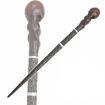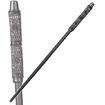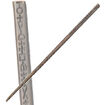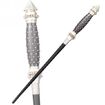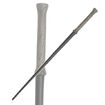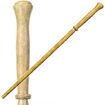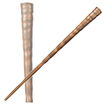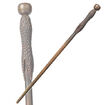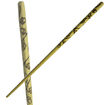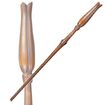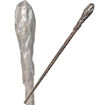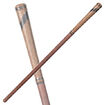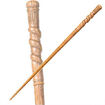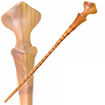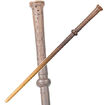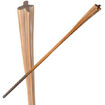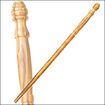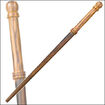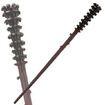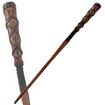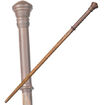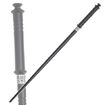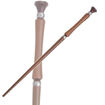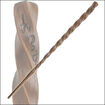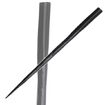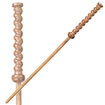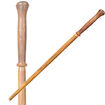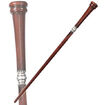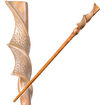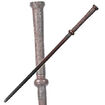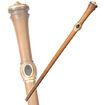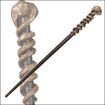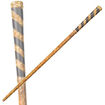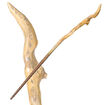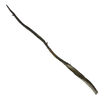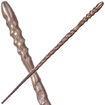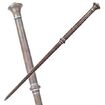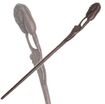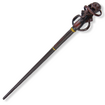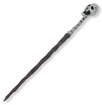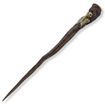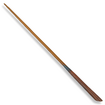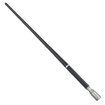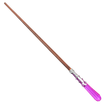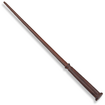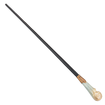Tag: Visual edit |
Seth Cooper (talk | contribs) (Dumbledore speculates the Peverells fashioned the Hallows themselves; Beedle's tale is allegorical and was written a couple of centuries after the fact) Tag: Undo |
||
| (20 intermediate revisions by 7 users not shown) | |||
| Line 2: | Line 2: | ||
{{Object infobox |
{{Object infobox |
||
|name = Wand |
|name = Wand |
||
| − | |image = |
+ | |image = Wands-Woods.png |
|location = |
|location = |
||
| − | |manufacturer = *[[Antioch Peverell]]<ref name="TBBR">{{TBB|R}}</ref> |
+ | |manufacturer = *[[Antioch Peverell]] (possibly)<ref name="DH21">{{DH|B|21}}</ref><ref name="TBBR">{{TBB|R}}</ref> |
*[[Ollivander family]] |
*[[Ollivander family]] |
||
*[[Mykew Gregorovitch]] |
*[[Mykew Gregorovitch]] |
||
*[[Jimmy Kiddell]] |
*[[Jimmy Kiddell]] |
||
*[[Arturo Cephalopos]] |
*[[Arturo Cephalopos]] |
||
| − | *[[Death (The Tale of the Three Brothers)|Death]] (Possibly)<ref name="DH21">{{DH|B|21}}</ref> |
||
*[[Violetta Beauvais]] |
*[[Violetta Beauvais]] |
||
*[[Johannes Jonker]] |
*[[Johannes Jonker]] |
||
| Line 18: | Line 17: | ||
|made = |
|made = |
||
|usage = Channelling [[magic]] |
|usage = Channelling [[magic]] |
||
| − | |owners = Most school-age and older [[Wizardkind|witches and wizards]] who |
+ | |owners = Most school-age and older [[Wizardkind|witches and wizards]] who had not had their wand broken or made unusable for any given reason. |
}} |
}} |
||
{{Quote|A wand is the object through which a witch or wizard channels his or her magic. It is made from wood and has a magical substance at its core. Wands made by Ollivander have cores of phoenix feather, unicorn hair or dragon heartstring, and are of varying woods, lengths, and flexibilities.|Description of a wand|Pottermore}} |
{{Quote|A wand is the object through which a witch or wizard channels his or her magic. It is made from wood and has a magical substance at its core. Wands made by Ollivander have cores of phoenix feather, unicorn hair or dragon heartstring, and are of varying woods, lengths, and flexibilities.|Description of a wand|Pottermore}} |
||
| ⚫ | A '''wand''' was a quasi-sentient [[magic]]al instrument through which a [[Wizardkind|witch or wizard]] channelled their magical powers to centralise the effects for more complex results.<ref name="PM"/> Most [[spell]]s were cast with the aid of wands, but spells could be cast [[Wandless magic|without the use of wands]]. Although wandless magic was more common in other countries, such as [[Africa]], European wizards were generally used to using the tool and found wandless magic more difficult, requiring much more concentration and skill. |
||
| + | Some magical creatures such as [[House-elf|house elves]] and [[goblin]]s were known to perform such magic and, in fact, were forbidden to carry wands. This had been a point of contention between wizards and goblins for centuries.<ref name="HBP">{{HBP}}</ref> |
||
| ⚫ | A '''wand''' |
||
| − | Wands |
+ | Wands were manufactured and sold by [[wandmaker]]s, the most famous of these in Great Britain being [[Garrick Ollivander|Ollivander]], and in Eastern Europe [[Mykew Gregorovitch|Gregorovitch]]. Each wand consisted of a specific type of [[Wand wood|wood]] that surrounded a [[Wand core|core]] of magical substance. Although the wand cores might come from the same creature, or the wood might come from the same tree, no two existing wands were exactly alike. The study of the history and the magical properties of wands was called [[wandlore]].<ref name="DH24"/> Wands were often buried or burned when their owner died.<ref name="TBB 104">{{TBB|R}}, pg 104</ref> |
==History== |
==History== |
||
| Line 38: | Line 38: | ||
==Magic and wands== |
==Magic and wands== |
||
| − | Magic with a wand |
+ | Magic with a wand was usually performed with an incantation, but more experienced wizards could cast [[nonverbal spell]]s, which concealed the spell until cast and might thereby prevent an opponent from adequately protecting him- or herself in time. Wands were referred to as "quasi-sentient" because their being imbued with a great deal of magic made them as animate as an inanimate object could be.<ref name="PCI">[http://www.accio-quote.org/articles/2007/1224-pottercast-anelli.html 24 December 2007 PotterCast Interviews with J.K. Rowling]</ref> |
| − | Every single wand |
+ | Every single wand was unique and would depend for its character on the particular tree and magical creature from which it derived its materials. Moreover, each wand, from the moment it found its ideal owner, would begin to learn from and teach its human partner. |
==Wands and wandlore== |
==Wands and wandlore== |
||
{{Quote|The wand chooses the wizard... it's not always clear why.|Ollivander discussing wandlore with Harry Potter|Harry Potter and the Philosopher's Stone}} |
{{Quote|The wand chooses the wizard... it's not always clear why.|Ollivander discussing wandlore with Harry Potter|Harry Potter and the Philosopher's Stone}} |
||
| ⚫ | [[Wandlore]] was a specific class of magic that referred to the history and magical properties of wands. [[Garrick Ollivander|Mr Ollivander]] claimed that it was a "complex and mysterious branch of magic".<ref name="DH24">{{DH|B|24}}</ref> The idea that a wand chose the wizard and could switch allegiance was a part of wandlore. |
||
| ⚫ | The Celtic Tree Calendar had assigned trees to different parts of the year and it sometimes played a part in wandlore. This calendar showed each month and the wood that went with it. Some wands and their owners aligned with the calendar such as: [[Harry Potter]], [[Hermione Granger]], [[Ronald Weasley|Ron Weasley]] (his first wand), and [[Draco Malfoy]]. Their wands were made of the wood that was linked to their date of birth. Harry was born between [[8 July]]–[[4 August]], and his wand wood was [[holly]]; Hermione was born between [[2 September]]–[[29 September]], and her wand wood was [[vine]]; Ron was born between [[18 February]]–[[17 March]], and his first wand was made of [[ash]]; Draco was born between [[13 May]]–[[9 June]], and his wand wood was [[hawthorn]].<ref name="PM">{{PM}}</ref> |
||
| ⚫ | [[Wandlore]] |
||
| − | |||
| ⚫ | The Celtic Tree Calendar |
||
===[[Wand wood]]s=== |
===[[Wand wood]]s=== |
||
| − | Most wands |
+ | Most wands were long, thin rods of wood with a magical substance embedded into their core. Among the woods used were: |
{| class="wikitable" border="1" width="95%" |
{| class="wikitable" border="1" width="95%" |
||
!Wood |
!Wood |
||
| Line 62: | Line 61: | ||
|[[Alder]] |
|[[Alder]] |
||
|''Alnus'' |
|''Alnus'' |
||
| − | |Alder is an unyielding wood, yet I have discovered that its ideal owner is not stubborn or obstinate, but often helpful, considerate and most |
+ | |Alder is an unyielding wood, yet I have discovered that its ideal owner is not stubborn or obstinate, but often helpful, considerate and most likable. Alder wood is well suited for making flutes and pipes, and for building bridges. Alder people are adventurous travellers and confident decision makers who trust their inner voices. Alder people should work hard to maintain a balance between work and play. <ref>https://shop.universalorlando.com/shop/harry-potter/collectibles/interactive-wands/interactive-ollivanders-alder-wand-1272546</ref> |
|- |
|- |
||
|[[Apple (tree)|Apple]] |
|[[Apple (tree)|Apple]] |
||
| Line 70: | Line 69: | ||
|[[Ash]] |
|[[Ash]] |
||
|''Fraxinus'' |
|''Fraxinus'' |
||
| − | |The ash wand cleaves to its one true master and ought not to be passed on or gifted from the original owner, because it will lose power and skill. This tendency is extreme if the core is of unicorn. |
+ | |The ash wand cleaves to its one true master and ought not to be passed on or gifted from the original owner, because it will lose power and skill. This tendency is extreme if the core is of unicorn. Tools, magical and ordinary, made from Ash are especially productive as Ash trees are known to attract energy. Ash people are kind and generous with a gift for seeing what is beautiful in the world and in others. Ash people should be careful that their romantic hearts do not lead them into danger. <ref>https://shop.universalorlando.com/shop/harry-potter/collectibles/interactive-wands/interactive-ollivanders-ash-wand-1272547</ref> |
|- |
|- |
||
|[[Aspen]] |
|[[Aspen]] |
||
| Line 168: | Line 167: | ||
|"''If you seek integrity, search first among the poplars"''. Here is a wand to rely upon, of consistency, strength and uniform power, always happiest when working with a witch or wizard of clear moral vision. |
|"''If you seek integrity, search first among the poplars"''. Here is a wand to rely upon, of consistency, strength and uniform power, always happiest when working with a witch or wizard of clear moral vision. |
||
|- |
|- |
||
| − | |[[Red oak |
+ | |[[Red oak]] |
|''Quercus rubra'' |
|''Quercus rubra'' |
||
|You will often hear the ignorant say that red oak is an infallible sign of its owner’s hot temper. In fact, the true match for a red oak wand is possessed of unusually fast reactions, making it a perfect duelling wand. |
|You will often hear the ignorant say that red oak is an infallible sign of its owner’s hot temper. In fact, the true match for a red oak wand is possessed of unusually fast reactions, making it a perfect duelling wand. |
||
| Line 196: | Line 195: | ||
|Unskilled wandmakers call spruce a difficult wood, but in doing so they reveal their own ineptitude. It is quite true that it requires particular deftness to work with spruce, which produces wands that are ill-matched with cautious or nervous natures, and become positively dangerous in fumbling fingers. |
|Unskilled wandmakers call spruce a difficult wood, but in doing so they reveal their own ineptitude. It is quite true that it requires particular deftness to work with spruce, which produces wands that are ill-matched with cautious or nervous natures, and become positively dangerous in fumbling fingers. |
||
|- |
|- |
||
| − | |[[ |
+ | |[[Snakewood]] |
| − | |Brosimum guianense |
+ | |''Brosimum guianense'' |
| |
| |
||
|- |
|- |
||
|[[Sugar Maple]] |
|[[Sugar Maple]] |
||
|''Acer saccharum'' |
|''Acer saccharum'' |
||
| + | | |
||
|- |
|- |
||
|[[Sycamore]] |
|[[Sycamore]] |
||
| Line 209: | Line 209: | ||
|[[Tamarack]] |
|[[Tamarack]] |
||
|''Larix laricina'' |
|''Larix laricina'' |
||
| + | | |
||
|- |
|- |
||
|[[Vine]] |
|[[Vine]] |
||
| Line 229: | Line 230: | ||
===[[Wand core]]s=== |
===[[Wand core]]s=== |
||
| − | Most wands made by Garrick Ollivander |
+ | Most wands made by Garrick Ollivander contained one of the three supreme core types, but there were others.<ref>{{WW|wand-cores}}</ref> Among the substances used were: |
{| class="wikitable" border="1" width="95%" |
{| class="wikitable" border="1" width="95%" |
||
|- |
|- |
||
| Line 240: | Line 241: | ||
|- |
|- |
||
|[[Dragon heartstring]] |
|[[Dragon heartstring]] |
||
| − | |As a rule, dragon heartstrings produce wands with the most power, and which are capable of the most flamboyant spells. [[Dragon]] wands tend to learn more quickly than other types. While they can change allegiance if won from their original master, they always bond strongly with the current owner. The dragon wand tends to be easiest to turn to the [[Dark Arts]], though it will not incline that way of its own accord. It is also the most prone of the three cores to accidents, being somewhat temperamental. |
+ | | As a rule, dragon heartstrings produce wands with the most power, and which are capable of the most flamboyant spells. [[Dragon]] wands tend to learn more quickly than other types. While they can change allegiance if won from their original master, they always bond strongly with the current owner. The dragon wand tends to be easiest to turn to the [[Dark Arts]], though it will not incline that way of its own accord. It is also the most prone of the three cores to accidents, being somewhat temperamental. |
|- |
|- |
||
|[[Phoenix feather]] [[File:Phoenix feather HP2 Jim Kay.png|120x120px|thumb|left]] |
|[[Phoenix feather]] [[File:Phoenix feather HP2 Jim Kay.png|120x120px|thumb|left]] |
||
| Line 249: | Line 250: | ||
|- |
|- |
||
|[[Thestral tail hair]] |
|[[Thestral tail hair]] |
||
| − | | |
+ | |This core type is regarded as an unstable, if not difficult substance to use in wand making. |
|- |
|- |
||
|[[Troll whisker]] |
|[[Troll whisker]] |
||
| − | |Troll whiskers is considered an inferior substance to [[Garrick Ollivander]]'s three Supreme Cores.<ref name="PM"/> |
+ | |Troll whiskers is considered an inferior substance to [[Garrick Ollivander]]'s three Supreme Cores.<ref name="PM" /> |
|- |
|- |
||
|[[Kelpie hair]] |
|[[Kelpie hair]] |
||
| − | |Early in my career, as I watched my wandmaker father wrestling with substandard wand core materials such as kelpie hair...<ref name="PM"/> |
+ | |Early in my career, as I watched my wandmaker father wrestling with substandard wand core materials such as kelpie hair...<ref name="PM" /> |
|- |
|- |
||
| ⚫ | |||
| − | |[[Thunderbird tail feather]] |
||
| ⚫ | |||
|The tail feather of the [[Thunderbird]] was used as a wand core by the American wandmaker [[Shikoba Wolfe]]. Wolfe's wands were powerful but difficult to master, and were good for [[transfiguration]] work.<ref name="PM-NorthAmerica" /> |
|The tail feather of the [[Thunderbird]] was used as a wand core by the American wandmaker [[Shikoba Wolfe]]. Wolfe's wands were powerful but difficult to master, and were good for [[transfiguration]] work.<ref name="PM-NorthAmerica" /> |
||
|- |
|- |
||
| − | |[[Wampus cat hair]] |
+ | |[[Wampus cat hair]]<ref name="PM-NorthAmerica" /> |
| − | <ref name="PM-NorthAmerica" /> |
||
|The hair of the Wampus cat was used as a wand core by the American wandmaker [[Johannes Jonker]]. Jonker experimented with many other cores before settling on the hair of this creature as his preferred kind. The core was also used by [[Isolt Sayre]] and [[James Steward]] when they begun making their own wands in the [[17th century]].<ref name="PM-NorthAmerica" /> |
|The hair of the Wampus cat was used as a wand core by the American wandmaker [[Johannes Jonker]]. Jonker experimented with many other cores before settling on the hair of this creature as his preferred kind. The core was also used by [[Isolt Sayre]] and [[James Steward]] when they begun making their own wands in the [[17th century]].<ref name="PM-NorthAmerica" /> |
||
|- |
|- |
||
| − | |[[White River Monster spine]] |
+ | |[[White River Monster spine]]<ref name="PM-NorthAmerica" /> |
| − | <ref name="PM-NorthAmerica" /> |
||
|This wand core was used by [[Thiago Quintana]]. White River Monster spines produce spells of force and elegance.<ref name="PM-NorthAmerica" /> |
|This wand core was used by [[Thiago Quintana]]. White River Monster spines produce spells of force and elegance.<ref name="PM-NorthAmerica" /> |
||
|- |
|- |
||
| − | |[[Rougarou hair]] |
+ | |[[Rougarou hair]]<ref name="PM-NorthAmerica" /> |
| − | <ref name="PM-NorthAmerica" /> |
||
|The hair of the rougarou was used as a wand core by the American wandmaker [[Violetta Beauvais]]. Rougarou hair was rumoured to have an affinity for Dark magic, like vampires to blood.<ref name="PM-NorthAmerica" /> |
|The hair of the rougarou was used as a wand core by the American wandmaker [[Violetta Beauvais]]. Rougarou hair was rumoured to have an affinity for Dark magic, like vampires to blood.<ref name="PM-NorthAmerica" /> |
||
|- |
|- |
||
| Line 291: | Line 288: | ||
==General wand properties== |
==General wand properties== |
||
{{Quote|Wands are only as powerful as the wizards who use them...|Hermione Granger explaining to [[Harry Potter]] wand properties|Harry Potter and the Deathly Hallows}} |
{{Quote|Wands are only as powerful as the wizards who use them...|Hermione Granger explaining to [[Harry Potter]] wand properties|Harry Potter and the Deathly Hallows}} |
||
| ⚫ | |||
| ⚫ | In almost all documented cases, the wand chose the wizard who matched its character because the wizard might have difficulty or be unable to perform magic if his or her wand's characters conflicted, or the magic might be sub-par to magic performed with a matching wand. Although [[Garrick Ollivander|Ollivander]] said that wizardkind could channel their powers through almost anything, optimum results could only be achieved with those they had a natural affinity for.<ref name="DH24" /> When trying out different wands, a wand that was not suited to its wielder would usually not do anything at all. However, a warm feeling was an indication of having chosen the right wand, and the wand sometimes emitted a few sparks or did some similar, small sign of magic.<ref name="PS5" /> |
||
| ⚫ | Wands were quasi-sentient: although they could not think or communicate like a human, they could perform certain actions through their own will. This ability may have been how they chose their wizard or witch and also explains Harry's wand's autonomously acting against [[Tom Riddle|Voldemort]].<ref name="DH4">{{DH|B|4}}</ref> |
||
| ⚫ | |||
| ⚫ | |||
| ⚫ | In almost all documented cases, the wand |
||
| − | |||
| ⚫ | Wands |
||
| − | |||
| ⚫ | |||
{{Quote|Many wandmakers simply match the wand length to the size of the witch or wizard who will use it, but this is a crude measure, and fails to take into account many other, important considerations. In my experience, longer wands might suit taller wizards, but they tend to be drawn to bigger personalities, and those of a more spacious and dramatic style of magic. Neater wands favour more elegant and refined spell-casting. However, no single aspect of wand composition should be considered in isolation of all the others, and the type of wood, the core and the flexibility may either counterbalance or enhance the attributes of the wand’s length.|[[Garrick Ollivander]] regarding wand length and flexibility|Pottermore}} |
{{Quote|Many wandmakers simply match the wand length to the size of the witch or wizard who will use it, but this is a crude measure, and fails to take into account many other, important considerations. In my experience, longer wands might suit taller wizards, but they tend to be drawn to bigger personalities, and those of a more spacious and dramatic style of magic. Neater wands favour more elegant and refined spell-casting. However, no single aspect of wand composition should be considered in isolation of all the others, and the type of wood, the core and the flexibility may either counterbalance or enhance the attributes of the wand’s length.|[[Garrick Ollivander]] regarding wand length and flexibility|Pottermore}} |
||
| ⚫ | |||
| ⚫ | Many wandmakers simply matched the wand length to the size of the witch or wizard who would use it, but this was a crude measure, and failed to take into account many other, important considerations. Longer wands might suit taller wizards, but they tended to be drawn to bigger personalities, and those of a more spacious and dramatic style of magic. Neater wands favoured more elegant and refined spell-casting. However, no single aspect of wand composition should be considered in isolation of all the others, and the type of wood, the core and the flexibility might either counterbalance or enhance the attributes of the wand’s length.<ref name="PML">{{WW|wand-lengths-and-flexibilit}}</ref> |
||
| ⚫ | Most wands would be in the range of between nine and fourteen inches. While extremely short wands (eight inches and under) and very long wands (over fifteen inches) existed, these were exceptionally rare. In the latter case, a physical peculiarity demanded the excessive wand length. However, abnormally short wands usually selected those in whose character something was lacking, rather than because they were physically undersized (many small witches and wizards are chosen by longer wands).<ref name="PML" /> |
||
| ⚫ | |||
| ⚫ | Wand flexibility or rigidity denoted the degree of adaptability and willingness to change possessed by the wand-and-owner pair — although, again, this factor ought not to be considered separately from the wand wood, core and length, nor of the owner’s life experience and style of magic, all of which would combine to make the wand in question unique.<ref name="PML" /> |
||
| ⚫ | Many wandmakers simply |
||
| − | |||
| ⚫ | Most wands |
||
| − | |||
| ⚫ | Wand flexibility or rigidity |
||
===New masters=== |
===New masters=== |
||
{{Quote|Harry looked down at the hawthorn wand that had once belonged to Draco Malfoy. He had been surprised, but pleased, to discover that it worked for him at least as well as Hermione's had done.|[[Harry Potter]] won the allegiance of Draco Malfoy's wand|Harry Potter and the Deathly Hallows}} |
{{Quote|Harry looked down at the hawthorn wand that had once belonged to Draco Malfoy. He had been surprised, but pleased, to discover that it worked for him at least as well as Hermione's had done.|[[Harry Potter]] won the allegiance of Draco Malfoy's wand|Harry Potter and the Deathly Hallows}} |
||
| ⚫ | |||
| + | Wands could take new masters. When a wand's master was disarmed, stunned, or killed, the wand might accept the old master's attacker as its new master. It swayed its allegiance over to the wizard who had won it from its preceding owner. Wands with [[dragon heartstring]] cores were said to be more likely to change their alliegence, though they would bond most strongly with their original owners.<ref>{{WW|wand-cores}}</ref> |
||
| ⚫ | Most wands were attached to their masters and would not easily discontinue their allegiance with the previous master, if at all. Indeed the original bond seemed unlikely to be severed; if it had been, then a defeated witch or wizard would have been better served to acquire a new wand rather than continue using it because it would have no longer performed at its peak for them — yet they didn't. Furthermore, wands forcibly taken in circumstances of purely competitive or friendly nature or stolen without attacking the previous master would not change allegiance.<ref name="Pottermore">[http://pottercast.the-leaky-cauldron.org/episode/show/167 Pottercast 131]</ref> |
||
| ⚫ | |||
| − | + | A notable exception to this general rule was the [[Elder Wand]], which, according to [[Albus Dumbledore]], only respected power. The Elder Wand would transfer its allegiance even if its defeated master was not in possession of it at the time. No other wand was known to share this trait. The Elder Wand's alliegence could be won as simply as by forcibly taking it from its current master's hand, as [[Harry Potter]] did with [[Draco Malfoy]], although it was more frequentely obtained by murder.<ref name="DH">{{DH}}</ref> |
|
| − | |||
| ⚫ | Most wands |
||
===Reverse Spell=== |
===Reverse Spell=== |
||
| − | [[File:Priori Incantatem Pottermore.png| |
+ | [[File:Priori Incantatem Pottermore.png|250px|thumb|A famous instance of the Reverse Spell effect occurred during Harry Potter's and Lord Voldemort's duel in [[Little Hangleton]]]] |
| ⚫ | A record of all the spells a wand had used could be checked using the [[Reverse Spell]]. This was a prime reason why criminals who wished to act discreetly would not use their own wands to perform illegal spells, fearing this record would betray them; instead, they could borrow someone else's wand to act with impunity, letting the other owner take the fall.<ref name="GOF">{{GOF}}</ref><ref name="HBP" /> The record seemed to be rather intricate, as [[Peter Pettigrew]] took [[Tom Riddle's wand|Voldemort's wand]] in fear it might reveal his treason, suggesting the wand had such records (such as branding the [[Dark Mark]] onto Pettigrew himself).<ref>[[Rumours!]] section of {{JKRS}}</ref> |
||
| − | |||
| ⚫ | A record of all the spells a wand |
||
| − | ===Damage and underwater use=== |
+ | === Damage and underwater use=== |
| − | [[File:Obliviate backfire.gif| |
+ | [[File:Obliviate backfire.gif|250px|thumb|left|Lockhart using a broken wand to cast a Memory Charm, which backfired onto himself]] |
| − | Spells and physical damage |
+ | Spells and physical damage could irreparably damage wands, destroying or greatly diminishing their magical abilities. Attempts to repair the wand would not be effective, and the wand might break again while performing magic, or even backfire, as was the case with [[Spellotape]]d wands.<ref name="COS" /> |
| − | The only known way to fully repair a broken wand |
+ | The only known way to fully repair a broken wand was through mastery of the [[Elder Wand]], although this ability might be lost if the current master died undefeated because most of the wand's power would disappear with them.<ref name="DH" /> |
| − | In addition, wands |
+ | In addition, wands seemed to possess the capability to function underwater, although the appearance of spells might change, as was demonstrated when Harry Potter attempted to use a [[Revulsion Jinx]] to free himself from the grip of several [[Grindylow]]s. Harry noted that instead of "sending sparks at the Grindylows", it "pelted them with what seemed to be a jet of boiling water".<ref name="GOF" /> |
==Acquiring a wand== |
==Acquiring a wand== |
||
| − | [[File:PS Harry getting his wand.gif| |
+ | [[File:PS Harry getting his wand.gif|250px|thumb|right|Harry Potter acquiring his wand at Ollivanders]] |
| ⚫ | Most witches and wizards bought their first wand when they were eleven — just before starting their magical education. Most English wizards and witches bought their wands at [[Ollivanders]] in [[Diagon Alley]], where they would try out multiple wands until they found the one that suited them, or rather, the wand found the wizard that suited it. Some witches and wizards, especially those from poorer backgrounds, were left to use wands that had not chosen them but chosen a member of their family: [[Ronald Weasley|Ron Weasley]], for example, used his brother [[Charles Weasley|Charlie]]'s [[Ronald Weasley's first wand|old wand]] when he began his first year at [[Hogwarts School of Witchcraft and Wizardry|Hogwarts]]. |
||
| ⚫ | In the [[United States of America]], upon purchasing a wand, the buyer was given a [[Wand Registration Number]], which was required for [[MACUSA Application for Wand Permit|applications]] for [[wand permit]]s. [[Magical Congress of the United States of America|MACUSA]] had a [[Central Wand Archive]].<ref name="Source">See [[:File:Wand_Permit_-_full.png|this image]]</ref> |
||
| ⚫ | Most witches and wizards |
||
| − | |||
| ⚫ | In the [[United States of America]], upon purchasing a wand, the buyer |
||
===Rights of usage=== |
===Rights of usage=== |
||
| Line 342: | Line 333: | ||
The right to carry a wand at all times was established by the [[International Confederation of Wizards]] in 1692, when Muggle persecution was at its height and the wizards were planning their retreat into hiding.<ref name="QTA 28">{{QTA|R}}, pg 28</ref> |
The right to carry a wand at all times was established by the [[International Confederation of Wizards]] in 1692, when Muggle persecution was at its height and the wizards were planning their retreat into hiding.<ref name="QTA 28">{{QTA|R}}, pg 28</ref> |
||
| − | + | Non-human [[being]]s as [[goblin]]s and [[House-elf|house-elves]] were prohibited from owning or using wands. For goblins in particular, this prohibition had been a point of contention with the [[Wizarding world|wizarding community]] and caused some [[Goblin Rebellions|outbreaks of violence]]. No known formal prohibition existed against [[Non-magic people|Muggle]]s possessing a wand; they would be unable to use them anyway since Muggles didn't possess magic, but a Muggle's possession of a wand could be considered a breach of the [[International Statute of Wizarding Secrecy]]. |
|
| − | Any underage wizards or witches who |
+ | Any underage wizards or witches who were expelled from school were forbidden from practising magic any further, and their wands had been confiscated and destroyed. [[Rubeus Hagrid's wand]] suffered such a fate, though it was somewhat repaired and kept inside [[Rubeus Hagrid's umbrella|his umbrella]], and he was allowed to use that much. However, if the student in question was expelled ''after'' taking the [[Ordinary Wizarding Level]], they were deemed to be full-fledged wizards and might retain their wands, as [[Newton Scamander]] did when he was expelled. [[Gellert Grindelwald]] was expelled from [[Durmstrang Institute|Durmstrang]], but he managed to maintain his wand (or procure another one), suggesting the wand confiscation may have only applied to [[Hogwarts School of Witchcraft and Wizardry|Hogwarts]] students. Of course, any criminals arrested and imprisoned lost their wands as well: [[Bartemius Crouch Junior|Barty Crouch Jnr]] claimed that he was not allowed a wand since [[Azkaban]]; though their wands seemed not destroyed but simply stored away because [[Bellatrix Lestrange]] managed to retrieve her old wand after escaping prison. |
| − | Years ago, due to [[Rappaport's Law]], no underaged North American witch or wizard was allowed a wand until they arrived at [[Ilvermorny School of Witchcraft and Wizardry]]. Moreover, wands had to be left at Ilvermorny during vacations and only upon attaining seventeen years of age was the witch or wizard legally allowed to carry a wand outside school. However, this law |
+ | Years ago, due to [[Rappaport's Law]], no underaged North American witch or wizard was allowed a wand until they arrived at [[Ilvermorny School of Witchcraft and Wizardry]]. Moreover, wands had to be left at Ilvermorny during vacations and only upon attaining seventeen years of age was the witch or wizard legally allowed to carry a wand outside school. However, this law had since been repealed (in [[1965]]). |
During the [[1997–1998 school year|last year]] of the [[Second Wizarding War]], the [[British Ministry of Magic]] was overthrown by the [[Death Eaters]], and new laws were put into effect. [[Muggle-born]] witches and wizards were regarded as having "stolen" their magic from "real" witches and wizards, and their wands (which were also considered stolen) were confiscated. Those who were not imprisoned were usually left [[Wandless|destitute]]. |
During the [[1997–1998 school year|last year]] of the [[Second Wizarding War]], the [[British Ministry of Magic]] was overthrown by the [[Death Eaters]], and new laws were put into effect. [[Muggle-born]] witches and wizards were regarded as having "stolen" their magic from "real" witches and wizards, and their wands (which were also considered stolen) were confiscated. Those who were not imprisoned were usually left [[Wandless|destitute]]. |
||
| Line 352: | Line 343: | ||
==Makers== |
==Makers== |
||
{{Main|Wandmaker}} |
{{Main|Wandmaker}} |
||
| ⚫ | |||
| ⚫ | |||
| ⚫ | The wand was originally a European invention, and although many makers of wands existed, [[Garrick Ollivander|Ollivander]] was the best known and most experienced in Britain. The wandmaking establishment had been making wands since [[B.C. era|382 BC]] and was in [[Diagon Alley]], [[London]]. Mr Ollivander went missing in the summer of [[1996]]<ref name="HBP" /> until discovered by Harry, Ron and Hermione and rescued by the house-elf [[Dobby]] in [[1998]]; he had been kidnapped by [[Death Eaters]] on [[Tom Riddle|Voldemort]]'s orders. Ollivander thereafter told Harry about the Elder Wand and how a wand passed ownership.<ref name="DH24" /> |
||
| ⚫ | |||
| ⚫ | |||
| ⚫ | |||
| + | Another notable wand maker was [[Mykew Gregorovitch]], who had once obtained and studied the [[Elder Wand]]. Gregorovitch's reputation rivalled that of Ollivander's with some, like [[Viktor Krum]], considering his wands the best in the world. Krum's statement also suggests this view was more common outside of Britain. By [[1997]] he had retired as a wand maker, with Krum purchasing one of his [[Viktor Krum's wand|last wands]]. In 1997, [[Tom Riddle|Voldemort]] tracked him down, as part of his quest to find and obtain [[Elder Wand]]. However, by that time, the wand had long since it had left Gregorovitch's possession, having been stolen by a [[Gellert Grindelwald|blond-haired young man]] that the wand maker had never identified. Once Voldemort finished questioning Gregorovitch, he murdered him as he was of no more use to the dark wizard.<ref name="DH" /> |
||
| ⚫ | The wand was originally a European invention, and although many makers of wands |
||
| ⚫ | |||
| ⚫ | |||
| − | |||
| − | Another notable wand maker was [[Mykew Gregorovitch]], who had made the wand of [[Viktor Krum]] and once wielded the [[Elder Wand]]. In [[1997]] he was tracked down and questioned by [[Tom Riddle|Voldemort]] in Voldemort's quest to find the [[Elder Wand]]. Once Voldemort finished questioning Gregorovitch, he murdered him.<ref name="DH" /> |
||
| − | |||
| ⚫ | |||
According to legend, [[Death (The Tale of the Three Brothers)|Death]] created the [[Elder Wand]], the most powerful wand in existence, from the branch of an elder tree. [[Albus Dumbledore]], however, believed that [[Antioch Peverell]] was more the likely creator.<ref name="TBB">{{TBB|E}}</ref> |
According to legend, [[Death (The Tale of the Three Brothers)|Death]] created the [[Elder Wand]], the most powerful wand in existence, from the branch of an elder tree. [[Albus Dumbledore]], however, believed that [[Antioch Peverell]] was more the likely creator.<ref name="TBB">{{TBB|E}}</ref> |
||
==Known wands== |
==Known wands== |
||
| − | {| class="wikitable" |
+ | {| class="wikitable" cellspacing="1" cellpadding="4" border="2" |
|- bgcolor="#cccccc" |
|- bgcolor="#cccccc" |
||
| − | !Owner |
+ | ! Owner |
!Wood |
!Wood |
||
!Length |
!Length |
||
!Core |
!Core |
||
!Flexibility |
!Flexibility |
||
| − | !Notes |
+ | ! Notes |
|- |
|- |
||
| − | | |
+ | | |
[[Albus Dumbledore]] |
[[Albus Dumbledore]] |
||
[[File:The Elder Wand.JPG|120px|thumb|left]] |
[[File:The Elder Wand.JPG|120px|thumb|left]] |
||
| Line 383: | Line 372: | ||
|[[Thestral tail hair]] |
|[[Thestral tail hair]] |
||
|Unknown |
|Unknown |
||
| − | |The [[Elder Wand]], one of the [[Deathly Hallows]]. Also known as the Deathstick and the Wand of Destiny. |
+ | | The [[Elder Wand]], one of the [[Deathly Hallows]]. Also known as the Deathstick and the Wand of Destiny. |
|- |
|- |
||
| |
| |
||
| Line 401: | Line 390: | ||
|[[Troll whisker]] (according to legend) |
|[[Troll whisker]] (according to legend) |
||
|Combustible (according to legend) |
|Combustible (according to legend) |
||
| − | |This wand was broken during [[Cadogan|Sir Cadogan]]'s encounter with the [[Wyvern of Wye]]. However, Cadogan still tried to combat the beast even with a broken wand, which led to his victory when the wand pierced the Wyvern's tongue and ignited its stomach fumes.<ref name="PM"/> |
+ | |This wand was broken during [[Cadogan|Sir Cadogan]]'s encounter with the [[Wyvern of Wye]]. However, Cadogan still tried to combat the beast even with a broken wand, which led to his victory when the wand pierced the Wyvern's tongue and ignited its stomach fumes.<ref name="PM" /> |
|- |
|- |
||
| |
| |
||
[[Cedric Diggory]] |
[[Cedric Diggory]] |
||
[[File:Cedricdiggorywandnn8202.jpg|120px|thumb|left]] |
[[File:Cedricdiggorywandnn8202.jpg|120px|thumb|left]] |
||
| − | |[[Ash]]<ref name="GOF18"/> |
+ | |[[Ash]]<ref name="GOF18" /> |
| − | |12¼"<ref name="GOF18"/> |
+ | |12¼"<ref name="GOF18" /> |
| − | |[[Unicorn hair]]<ref name="GOF18"/> |
+ | |[[Unicorn hair]]<ref name="GOF18" /> |
|Pleasantly springy |
|Pleasantly springy |
||
| − | |This [[Cedric Diggory's wand|wand]] was "pleasantly springy"; hair from particularly fine male [[unicorn]] (seventeen hands high), which nearly gored [[Garrick Ollivander|Mr Ollivander]] with its horn after he plucked its tail hair.<ref name="GOF18"/> |
+ | |This [[Cedric Diggory's wand|wand]] was "pleasantly springy"; hair from particularly fine male [[unicorn]] (seventeen hands high), which nearly gored [[Garrick Ollivander|Mr Ollivander]] with its horn after he plucked its tail hair.<ref name="GOF18" /> |
|- |
|- |
||
|[[Celestina Warbeck]] |
|[[Celestina Warbeck]] |
||
| Line 426: | Line 415: | ||
|[[Dragon heartstring]] |
|[[Dragon heartstring]] |
||
|Unknown |
|Unknown |
||
| − | |This [[Dolores Umbridge's wand|wand]] is described as "unusually short;" broken by a [[centaur]]'s hoof in June 1996 in the [[Forbidden Forest]].<ref name="OOTP"/> |
+ | | This [[Dolores Umbridge's wand|wand]] is described as "unusually short;" broken by a [[centaur]]'s hoof in June 1996 in the [[Forbidden Forest]].<ref name="OOTP" /> |
|- |
|- |
||
| |
| |
||
[[Draco Malfoy]] |
[[Draco Malfoy]] |
||
[[File:Draco Malfoy Wand.jpg|120px|thumb|left]] |
[[File:Draco Malfoy Wand.jpg|120px|thumb|left]] |
||
| − | |[[Hawthorn]]<ref name="DH24"/> |
+ | |[[Hawthorn]]<ref name="DH24" /> |
| − | |10"<ref name="DH24"/> |
+ | |10"<ref name="DH24" /> |
| − | |[[Unicorn hair]]<ref name="DH24"/> |
+ | |[[Unicorn hair]]<ref name="DH24" /> |
| − | |Reasonably springy<ref name="DH24"/> |
+ | |Reasonably springy<ref name="DH24" /> |
| − | |This [[Draco Malfoy's wand|wand]] passed into the possession of Harry Potter after the [[Skirmish at Malfoy Manor]] in 1998 until Harry came into possession of the Elder Wand and mended his first wand.<ref name="DH24"/> |
+ | |This [[Draco Malfoy's wand|wand]] passed into the possession of Harry Potter after the [[Skirmish at Malfoy Manor]] in 1998 until Harry came into possession of the Elder Wand and mended his first wand.<ref name="DH24" /> |
|- |
|- |
||
| |
| |
||
[[Fleur Delacour]] |
[[Fleur Delacour]] |
||
[[File:FleurDelacourWandNN8246.jpg|120px|thumb|left]] |
[[File:FleurDelacourWandNN8246.jpg|120px|thumb|left]] |
||
| − | |[[Rosewood]]<ref name="GOF18"/> |
+ | |[[Rosewood]]<ref name="GOF18" /> |
| − | |9½"<ref name="GOF18"/> |
+ | |9½"<ref name="GOF18" /> |
| − | |[[Veela hair]]<ref name="GOF18"/> |
+ | |[[Veela hair]]<ref name="GOF18" /> |
| − | |Inflexible<ref name="GOF18"/> |
+ | |Inflexible<ref name="GOF18" /> |
| − | |In this [[Fleur Delacour's wand|wand]] the core is a hair from Fleur's [[Apolline Delacour's mother|grandmother]], who was a [[Veela]].<ref name="GOF18"/> |
+ | |In this [[Fleur Delacour's wand|wand]] the core is a hair from Fleur's [[Apolline Delacour's mother|grandmother]], who was a [[Veela]].<ref name="GOF18" /> |
|- |
|- |
||
| |
| |
||
| Line 451: | Line 440: | ||
|12¾" |
|12¾" |
||
| colspan="1" rowspan="2" |[[Dragon heartstring]] |
| colspan="1" rowspan="2" |[[Dragon heartstring]] |
||
| − | | colspan="1" rowspan="2" |Slightly bendy |
+ | | colspan="1" rowspan="2" | Slightly bendy |
| |
| |
||
|- |
|- |
||
| Line 464: | Line 453: | ||
[[Harry Potter]] ([[Harry Potter's wand|wand #1]]) |
[[Harry Potter]] ([[Harry Potter's wand|wand #1]]) |
||
[[File:HarryPotterWandNN8415.jpg|120px|thumb|left]] |
[[File:HarryPotterWandNN8415.jpg|120px|thumb|left]] |
||
| − | |[[Holly]]<ref name="PS5"/> |
+ | |[[Holly]]<ref name="PS5" /> |
| − | |11"<ref name="PS5"/> |
+ | |11"<ref name="PS5" /> |
| − | |[[Phoenix feather]]<ref name="PS5"/> |
+ | |[[Phoenix feather]]<ref name="PS5" /> |
| − | |Nice and supple<ref name="PS5"/> |
+ | |Nice and supple<ref name="PS5" /> |
| |
| |
||
| − | "Brother" to [[Tom Riddle|Voldemort]]'s wand — the core tail feathers are both from [[Fawkes]]; broken in December [[1997]] while [[Attack at Godric's Hollow (1997)|fleeing from Godric's Hollow]];<ref name="PS5">{{PS|B|5}}</ref> repaired with the [[Elder Wand]] in May 1998.<ref name="DH"/> |
+ | "Brother" to [[Tom Riddle|Voldemort]]'s wand — the core tail feathers are both from [[Fawkes]]; broken in December [[1997]] while [[Attack at Godric's Hollow (1997)|fleeing from Godric's Hollow]];<ref name="PS5">{{PS|B|5}}</ref> repaired with the [[Elder Wand]] in May 1998.<ref name="DH" /> |
|- |
|- |
||
| |
| |
||
| Line 476: | Line 465: | ||
|[[Blackthorn]] |
|[[Blackthorn]] |
||
|10" |
|10" |
||
| − | |Unknown |
+ | | Unknown |
| colspan="1" rowspan="2" |Unknown |
| colspan="1" rowspan="2" |Unknown |
||
| − | | |
+ | |This [[blackthorn wand|wand]] was taken from a [[Snatchers|Snatcher]] by Ron Weasley in [[1997]], and used by Harry until [[1998]], when he took [[Draco Malfoy's wand]]. |
|- |
|- |
||
| |
| |
||
| Line 499: | Line 488: | ||
[[James Potter I|James Potter]] |
[[James Potter I|James Potter]] |
||
[[File:JamesPotterWand_NN8206.jpg|120px|thumb|left|James Potter's wand]] |
[[File:JamesPotterWand_NN8206.jpg|120px|thumb|left|James Potter's wand]] |
||
| − | |[[Mahogany]]<ref name="PS5"/> |
+ | |[[Mahogany]]<ref name="PS5" /> |
| − | |11"<ref name="PS5"/> |
+ | | 11"<ref name="PS5" /> |
| colspan="1" rowspan="2" |Unknown |
| colspan="1" rowspan="2" |Unknown |
||
| − | |Pliable<ref name="PS5"/> |
+ | |Pliable<ref name="PS5" /> |
| − | |This [[James Potter's wand|wand]] was "excellent for [[transfiguration]]."<ref name="PS5"/> |
+ | |This [[James Potter's wand|wand]] was "excellent for [[transfiguration]]."<ref name="PS5" /> |
|- |
|- |
||
|[[Lily J. Potter|Lily Evans]] |
|[[Lily J. Potter|Lily Evans]] |
||
| − | |[[Willow]]<ref name="PS5"/> |
+ | |[[Willow]]<ref name="PS5" /> |
| − | |10¼"<ref name="PS5"/> |
+ | |10¼"<ref name="PS5" /> |
| − | |Swishy<ref name="PS5"/> |
+ | |Swishy<ref name="PS5" /> |
| − | |This [[Lily Evans' wand|wand]] was "nice for [[Charm]] work."<ref name="PS5"/> |
+ | | This [[Lily Evans' wand|wand]] was "nice for [[Charm]] work."<ref name="PS5" /> |
|- |
|- |
||
| |
| |
||
| Line 518: | Line 507: | ||
|[[Dragon heartstring]] |
|[[Dragon heartstring]] |
||
|Unknown |
|Unknown |
||
| − | |This [[Lucius Malfoy's wand|wand]] was kept in a [[Lucius Malfoy's walking stick|snake-headed walking stick]] that Lucius carried; "borrowed" by Lord Voldemort and destroyed by [[Harry Potter's wand]] during the [[Battle of the Seven Potters]] in 1997.<ref name="DH"/> |
+ | |This [[Lucius Malfoy's wand|wand]] was kept in a [[Lucius Malfoy's walking stick|snake-headed walking stick]] that Lucius carried; "borrowed" by Lord Voldemort and destroyed by [[Harry Potter's wand]] during the [[Battle of the Seven Potters]] in 1997.<ref name="DH" /> |
|- |
|- |
||
|[[Mary Cattermole]] |
|[[Mary Cattermole]] |
||
| Line 525: | Line 514: | ||
|[[Unicorn hair]] |
|[[Unicorn hair]] |
||
|Unknown |
|Unknown |
||
| − | |This [[Mary Cattermole's wand|wand]] was confiscated by the [[Muggle-Born Registration Commission]] in [[1997]].<ref name="DH"/> |
+ | |This [[Mary Cattermole's wand|wand]] was confiscated by the [[Muggle-Born Registration Commission]] in [[1997]].<ref name="DH" /> |
|- |
|- |
||
|[[Merlin]] |
|[[Merlin]] |
||
| − | |Believed to have been [[English oak]].<ref name="PM"/> |
+ | |Believed to have been [[English oak]].<ref name="PM" /> |
| colspan="3" rowspan="1" |Unknown |
| colspan="3" rowspan="1" |Unknown |
||
| |
| |
||
| Line 547: | Line 536: | ||
|Unknown |
|Unknown |
||
|[[Unicorn hair]] |
|[[Unicorn hair]] |
||
| − | |Unknown |
+ | | Unknown |
|[[Neville Longbottom's second wand|This wand]] may have been one of the last wands [[Garrick Ollivander|Mr Ollivander]] sold before he disappeared in 1996. |
|[[Neville Longbottom's second wand|This wand]] may have been one of the last wands [[Garrick Ollivander|Mr Ollivander]] sold before he disappeared in 1996. |
||
|- |
|- |
||
| Line 571: | Line 560: | ||
[[File:Remus wand.jpg|120px|thumb|left]] |
[[File:Remus wand.jpg|120px|thumb|left]] |
||
|[[Cypress]] |
|[[Cypress]] |
||
| − | |10¼" |
+ | | 10¼" |
|Pliable |
|Pliable |
||
|Cypress wands are said to be well-matched to wizards who are self-sacrificing and willing to die a heroic death. Lupin spent the majority of his life alone to save others from having to deal with the consequences of his affliction, and died defending Hogwarts castle in the [[Battle of Hogwarts]]. |
|Cypress wands are said to be well-matched to wizards who are self-sacrificing and willing to die a heroic death. Lupin spent the majority of his life alone to save others from having to deal with the consequences of his affliction, and died defending Hogwarts castle in the [[Battle of Hogwarts]]. |
||
| Line 587: | Line 576: | ||
[[File:RonWeasleyWandNN8413.jpg|120px|thumb|left]] |
[[File:RonWeasleyWandNN8413.jpg|120px|thumb|left]] |
||
|[[Willow]] |
|[[Willow]] |
||
| − | |14" |
+ | | 14" |
|Purchased with [[Arthur Weasley|his father]]'s winnings from a ''[[Daily Prophet]]'' draw. Taken from him by Snatchers and replaced with Peter Pettigrew's wand. |
|Purchased with [[Arthur Weasley|his father]]'s winnings from a ''[[Daily Prophet]]'' draw. Taken from him by Snatchers and replaced with Peter Pettigrew's wand. |
||
|- |
|- |
||
| Line 624: | Line 613: | ||
[[Viktor Krum]] |
[[Viktor Krum]] |
||
[[File:ViktorKrumWand.jpg|120px|thumb|left]] |
[[File:ViktorKrumWand.jpg|120px|thumb|left]] |
||
| − | |[[Hornbeam]]<ref name="GOF18"/> |
+ | |[[Hornbeam]]<ref name="GOF18" /> |
| − | |10¼"<ref name="GOF18"/> |
+ | |10¼"<ref name="GOF18" /> |
| − | |[[Dragon heartstring]]<ref name="GOF18"/> |
+ | |[[Dragon heartstring]]<ref name="GOF18" /> |
| − | |Quite rigid<ref name="GOF18"/> |
+ | |Quite rigid<ref name="GOF18" /> |
|This [[Viktor Krum's wand|wand]] is thicker than usual, and made by [[Mykew Gregorovitch|Gregorovitch]].<ref name="GOF18">{{GOF|B|18}}</ref> |
|This [[Viktor Krum's wand|wand]] is thicker than usual, and made by [[Mykew Gregorovitch|Gregorovitch]].<ref name="GOF18">{{GOF|B|18}}</ref> |
||
|- |
|- |
||
| Line 635: | Line 624: | ||
|[[Yew]] |
|[[Yew]] |
||
| colspan="3" rowspan="1" |Unknown |
| colspan="3" rowspan="1" |Unknown |
||
| − | |A yew wand is suited for a person who is a fierce protector of others.<ref name="PM"/> Protectiveness is an espect of Ginny's personality. She has frequently defended [[Harry Potter]] against others.<ref name="COS">{{COS}}</ref><ref name="OOTP">{{OOTP}}</ref><ref name="HBP">{{HBP}}</ref> |
+ | |A yew wand is suited for a person who is a fierce protector of others.<ref name="PM" /> Protectiveness is an espect of Ginny's personality. She has frequently defended [[Harry Potter]] against others.<ref name="COS">{{COS}}</ref><ref name="OOTP">{{OOTP}}</ref><ref name="HBP">{{HBP}}</ref> |
|- |
|- |
||
| |
| |
||
[[Sybill Trelawney]] |
[[Sybill Trelawney]] |
||
[[File:ProfSybilTrelawneyWandNN8254.jpg|120px|thumb|left]] |
[[File:ProfSybilTrelawneyWandNN8254.jpg|120px|thumb|left]] |
||
| − | |[[Hazel]]<ref name="PM"/> |
+ | |[[Hazel]]<ref name="PM" /> |
| − | |9½"<ref name="PM"/> |
+ | | 9½"<ref name="PM" /> |
| − | |[[Unicorn hair]]<ref name="PM"/> |
+ | |[[Unicorn hair]]<ref name="PM" /> |
| − | |Very flexible<ref name="PM"/> |
+ | |Very flexible<ref name="PM" /> |
| − | |This wand bears a resemblance to [[Sirius Black's wand]], though there are slight differences. They both have a square-like handle and have magical runes depicted on the wand, but Trelawney's wand has a darker colour and has a swirly shape from the handle to the tip. |
+ | | This wand bears a resemblance to [[Sirius Black's wand]], though there are slight differences. They both have a square-like handle and have magical runes depicted on the wand, but Trelawney's wand has a darker colour and has a swirly shape from the handle to the tip. |
|- |
|- |
||
|[[Dylan Marwood]] |
|[[Dylan Marwood]] |
||
| Line 653: | Line 642: | ||
|[[The Silver Spears]] |
|[[The Silver Spears]] |
||
|[[Aspen]] |
|[[Aspen]] |
||
| − | |The Silver Spears was a notorious and secretive [[duelling]] club in the 18th century that allegedly only allowed wizards and witches who possessed wands made from aspen wood to join.<ref name="PM"/> |
+ | |The Silver Spears was a notorious and secretive [[duelling]] club in the 18th century that allegedly only allowed wizards and witches who possessed wands made from aspen wood to join.<ref name="PM" /> |
|- |
|- |
||
|[[Eldritch Diggory]] |
|[[Eldritch Diggory]] |
||
| Line 659: | Line 648: | ||
| colspan="2" rowspan="2" |Unknown |
| colspan="2" rowspan="2" |Unknown |
||
| colspan="1" rowspan="2" |Fine |
| colspan="1" rowspan="2" |Fine |
||
| − | | rowspan="2" |The existence of this wand and its owners was cited as evidence against a myth that poplar wands never chose politicians.<ref name="PM"/> |
+ | | rowspan="2" |The existence of this wand and its owners was cited as evidence against a myth that poplar wands never chose politicians.<ref name="PM" /> |
|- |
|- |
||
|[[Evangeline Orpington]] |
|[[Evangeline Orpington]] |
||
| Line 667: | Line 656: | ||
|9" |
|9" |
||
|[[Dragon heartstring]] |
|[[Dragon heartstring]] |
||
| − | |Nice and flexible |
+ | | Nice and flexible |
| colspan="1" rowspan="3" |These wands were tried out by Harry Potter in 1991. |
| colspan="1" rowspan="3" |These wands were tried out by Harry Potter in 1991. |
||
|- |
|- |
||
| Line 678: | Line 667: | ||
|8½" |
|8½" |
||
|[[Unicorn hair]] |
|[[Unicorn hair]] |
||
| − | |Springy |
+ | | Springy |
|- |
|- |
||
|[[Apple (tree)|Apple]] |
|[[Apple (tree)|Apple]] |
||
| Line 699: | Line 688: | ||
|Reasonably springy |
|Reasonably springy |
||
| rowspan="4" |One of these four wands was bought by Jacob's younger sibling in 1984. |
| rowspan="4" |One of these four wands was bought by Jacob's younger sibling in 1984. |
||
| − | (Player determined) |
||
|- |
|- |
||
|[[Acacia]] |
|[[Acacia]] |
||
| Line 707: | Line 695: | ||
|- |
|- |
||
|[[Hornbeam]] |
|[[Hornbeam]] |
||
| − | |11" |
+ | | 11" |
|[[Dragon heartstring]] |
|[[Dragon heartstring]] |
||
|Inflexible |
|Inflexible |
||
| Line 722: | Line 710: | ||
| |
| |
||
| rowspan="3" |One of these three wands was bought by Jacob's younger sibling in 1989 after their wand was destroyed by [[Patricia Rakepick]]. |
| rowspan="3" |One of these three wands was bought by Jacob's younger sibling in 1989 after their wand was destroyed by [[Patricia Rakepick]]. |
||
| − | (Player determined) |
||
|- |
|- |
||
|[[Redwood]] |
|[[Redwood]] |
||
| Line 801: | Line 788: | ||
[[File:Wand_1.jpg|thumb|Wands drawn on the covers of the American version of the books by [[Mary GrandPré]] are shown as extremely long and thin]] |
[[File:Wand_1.jpg|thumb|Wands drawn on the covers of the American version of the books by [[Mary GrandPré]] are shown as extremely long and thin]] |
||
[[File:LEGOHPWand.png|220x220px|thumb|A LEGO wand]] |
[[File:LEGOHPWand.png|220x220px|thumb|A LEGO wand]] |
||
| + | |||
| − | *In the films, the wands are shown a couple of inches longer than they are shown in the books. The films seem to include more gestures when using a wand, not just waving it and pointing it. The different styles were shown properly in the film version of the [[Battle of the Department of Mysteries]]. It may be explained that gestures and wand movements translate to incantations, even without words. This may allow one to speak the incantation without having to perform a specific gesture or wand movement. |
+ | *In the films, the wands are shown a couple of inches longer than they are shown in the books. The films seem to include more gestures when using a wand, not just waving it and pointing it. The different styles were shown properly in the film version of the [[Battle of the Department of Mysteries]]. It may be explained that gestures and wand movements translate to incantations, even without words. This may allow one to speak the incantation without having to perform a specific gesture or wand movement. |
*It is theorised that the wand's length is proportional to the wizard's height: the longer the wand, the taller the wizard, and the shorter the wand, the shorter the wizard. Although this pattern is generally supported (eg, [[Dolores Umbridge]]'s short wand, [[Rubeus Hagrid]]'s long wand) this may not always be the case. For example, Draco Malfoy, despite being tall, had a relatively short wand. However, J.K. Rowling stated that wands are generally shorter when witches or wizards are lacking in personality, rather than size. |
*It is theorised that the wand's length is proportional to the wizard's height: the longer the wand, the taller the wizard, and the shorter the wand, the shorter the wizard. Although this pattern is generally supported (eg, [[Dolores Umbridge]]'s short wand, [[Rubeus Hagrid]]'s long wand) this may not always be the case. For example, Draco Malfoy, despite being tall, had a relatively short wand. However, J.K. Rowling stated that wands are generally shorter when witches or wizards are lacking in personality, rather than size. |
||
*[[J. K. Rowling]] used a Celtic calendar to assign certain types of woods to [[Ronald Weasley|Ron Weasley]], [[Hermione Granger]], and [[Harry Potter]] based on their birthdates.<ref>[http://www.jkrowling.com/textonly/en/extrastuff_view.cfm?id=18 Extra Stuff] at {{JKRS}}</ref> |
*[[J. K. Rowling]] used a Celtic calendar to assign certain types of woods to [[Ronald Weasley|Ron Weasley]], [[Hermione Granger]], and [[Harry Potter]] based on their birthdates.<ref>[http://www.jkrowling.com/textonly/en/extrastuff_view.cfm?id=18 Extra Stuff] at {{JKRS}}</ref> |
||
*Wands are [[Warwick Davis]]' favourite prop on the series. |
*Wands are [[Warwick Davis]]' favourite prop on the series. |
||
| + | |||
[[File:Pottermore wands.jpg|250px|thumb|A variety of wands from {{PM}}]] |
[[File:Pottermore wands.jpg|250px|thumb|A variety of wands from {{PM}}]] |
||
| + | |||
| − | *In the first and second films, wands look quite plain. The appearance of wands drastically change in {{POA|FA}}, in which the wands are given distinctive shapes and carvings, reflecting the owner's personality. |
+ | * In the first and second films, wands look quite plain. The appearance of wands drastically change in {{POA|FA}}, in which the wands are given distinctive shapes and carvings, reflecting the owner's personality. |
| − | *Devon Murray, who plays Seamus Finnigan in the ''Harry Potter'' films, has the record for breaking the most prop wands. He broke eighty of them.<ref name="DHF2 BHTM>{{DH|F2}} - Behind the Magic</ref> Dan Radcliffe himself broke and damaged almost as many due to his habit of drumming with them. |
+ | *Devon Murray, who plays Seamus Finnigan in the ''Harry Potter'' films, has the record for breaking the most prop wands. He broke eighty of them.<ref name="DHF2 BHTM">{{DH|F2}} - Behind the Magic</ref> Dan Radcliffe himself broke and damaged almost as many due to his habit of drumming with them. |
*J.K. Rowling has said that Muggles cannot use a magic wand, yet residual power stored in a wand may discharge at odd moments, having potentially disastrous effects for a non-wizard.<ref name="TBB 83">{{TBB|R}}, pg 83</ref> One example of this happening was when, in [[1790]], [[Non-magic people|Muggle]] [[Bartholomew Barebone]] stole [[Dorcus Twelvetrees's wand]] and showed it to many reporters. The wand was said to have "a kick like a mule" when waved. Another example of such behaviour occurred when a Muggle by the name of James Stewart attempted to wave a wand, causing it to "rebel" and send him flying into a tree, knocking him out. This result was described as what "invariably happens when a No-Maj waves a wand". |
*J.K. Rowling has said that Muggles cannot use a magic wand, yet residual power stored in a wand may discharge at odd moments, having potentially disastrous effects for a non-wizard.<ref name="TBB 83">{{TBB|R}}, pg 83</ref> One example of this happening was when, in [[1790]], [[Non-magic people|Muggle]] [[Bartholomew Barebone]] stole [[Dorcus Twelvetrees's wand]] and showed it to many reporters. The wand was said to have "a kick like a mule" when waved. Another example of such behaviour occurred when a Muggle by the name of James Stewart attempted to wave a wand, causing it to "rebel" and send him flying into a tree, knocking him out. This result was described as what "invariably happens when a No-Maj waves a wand". |
||
*Although Harry's wand is known to be made of holly (an almost white wood), his prop wand is significantly darker, suggesting a different wood. However, other wands appear to be varnished or coloured, so this isn't necessarily a break in continuity. Wood is a matte material so most if not all wands in the films have some kind of colour treatment. |
*Although Harry's wand is known to be made of holly (an almost white wood), his prop wand is significantly darker, suggesting a different wood. However, other wands appear to be varnished or coloured, so this isn't necessarily a break in continuity. Wood is a matte material so most if not all wands in the films have some kind of colour treatment. |
||
| − | *Wands have been used a total of 763 times in the books, according to |
+ | *Wands have been used a total of 763 times in the books, according to{{PM}}.<ref>[https://www.pottermore.com/features/the-great-wand-o-graphic The Great Wand-o-Graphic] from {{PM}}</ref> |
| − | *[[Jacob's sibling]]'s wands are determined by the answer the player gives to the questions Ollivander poses to the character during their wand selection. During the game's beta release, a fourth response |
+ | *[[Jacob's sibling]]'s wands are determined by the answer the player gives to the questions Ollivander poses to the character during their wand selection. During the game's beta release, a fourth response existed in the first year ("I wanted answers") that would give the Maple wand, but is no longer available to players. An error exists during the selection of the character's second wand where Ollivander will mention that the player received the Hornbeam wand as their first, regardless of their choice.<ref name="HM11">{{HM|1|1}}</ref><ref name="ChapterSeventeen">{{HM|5|17}}</ref><ref>[https://www.gameskinny.com/jy3tl/harry-potter-hogwarts-mystery-wand-choice-starter-guide GameSkinny.com]</ref> |
| + | *[[Cherry (tree)|Cherry]] wood wands being sought after in [[Japan]], and their masters receiving special prestige, is likely a reference to the symbolism put on cherry blossoms 桜 (''sakura'') and their great popularity in Japanese culture. Sakura are also the national flower of Japan |
||
==Appearances== |
==Appearances== |
||
{{Imagecat|Images of wands}} |
{{Imagecat|Images of wands}} |
||
| + | |||
*{{PS}} {{1st}} |
*{{PS}} {{1st}} |
||
*{{PS|F}} |
*{{PS|F}} |
||
Revision as of 00:35, 31 August 2021

|
Warning!
At least some content in this article is derived from information featured in: Hogwarts Legacy & Harry Potter: Puzzles & Spells & Harry Potter: Magic Awakened & Harry Potter: Wizards Unite & Harry Potter: Hogwarts Mystery. |
- "A wand is the object through which a witch or wizard channels his or her magic. It is made from wood and has a magical substance at its core. Wands made by Ollivander have cores of phoenix feather, unicorn hair or dragon heartstring, and are of varying woods, lengths, and flexibilities."
- — Description of a wand[src]
A wand was a quasi-sentient magical instrument through which a witch or wizard channelled their magical powers to centralise the effects for more complex results.[3] Most spells were cast with the aid of wands, but spells could be cast without the use of wands. Although wandless magic was more common in other countries, such as Africa, European wizards were generally used to using the tool and found wandless magic more difficult, requiring much more concentration and skill.
Some magical creatures such as house elves and goblins were known to perform such magic and, in fact, were forbidden to carry wands. This had been a point of contention between wizards and goblins for centuries.[4]
Wands were manufactured and sold by wandmakers, the most famous of these in Great Britain being Ollivander, and in Eastern Europe Gregorovitch. Each wand consisted of a specific type of wood that surrounded a core of magical substance. Although the wand cores might come from the same creature, or the wood might come from the same tree, no two existing wands were exactly alike. The study of the history and the magical properties of wands was called wandlore.[5] Wands were often buried or burned when their owner died.[6]
History
Wands were developed in Europe[7][8] at an unknown point, though it is known that it was in the B.C. era. The Ollivander family started manufacturing wands in 382 B.C.[9] Over time, they earned a worldwide reputation.[10] In the 13th century, the Elder Wand, which would become known as the most powerful wand in existence, was created.
The first witch who was a wandmaker in North America was Irish witch Isolt Sayre[11], who came to North America and started making wands for her adoptive sons and the students of her school Ilvermorny with her husband James Steward. With the passage of Rappaport's Law, no child was allowed a wand until they arrived at Ilvermorny and they had to leave them there during the holidays until they reached the age of seventeen.[12] By the 1920s, the use of wands had become common in North America although every witch and wizard, including tourists, needed a Wand permit.[8]
At an unknown point in history, wands were introduced to Asia. Cherry wand masters received special prestige at Mahoutokoro school in Japan.[13]
In the 20th century, wands were introduced to Africa, where they were less commonly used compared to other parts of the world.[7]
There was at least one known business that specialised in tuning wands to improve their performance. Repair services were also available.
Magic and wands
Magic with a wand was usually performed with an incantation, but more experienced wizards could cast nonverbal spells, which concealed the spell until cast and might thereby prevent an opponent from adequately protecting him- or herself in time. Wands were referred to as "quasi-sentient" because their being imbued with a great deal of magic made them as animate as an inanimate object could be.[14]
Every single wand was unique and would depend for its character on the particular tree and magical creature from which it derived its materials. Moreover, each wand, from the moment it found its ideal owner, would begin to learn from and teach its human partner.
Wands and wandlore
- "The wand chooses the wizard... it's not always clear why."
- — Ollivander discussing wandlore with Harry Potter[src]
Wandlore was a specific class of magic that referred to the history and magical properties of wands. Mr Ollivander claimed that it was a "complex and mysterious branch of magic".[5] The idea that a wand chose the wizard and could switch allegiance was a part of wandlore.
The Celtic Tree Calendar had assigned trees to different parts of the year and it sometimes played a part in wandlore. This calendar showed each month and the wood that went with it. Some wands and their owners aligned with the calendar such as: Harry Potter, Hermione Granger, Ron Weasley (his first wand), and Draco Malfoy. Their wands were made of the wood that was linked to their date of birth. Harry was born between 8 July–4 August, and his wand wood was holly; Hermione was born between 2 September–29 September, and her wand wood was vine; Ron was born between 18 February–17 March, and his first wand was made of ash; Draco was born between 13 May–9 June, and his wand wood was hawthorn.[3]
Wand woods
Most wands were long, thin rods of wood with a magical substance embedded into their core. Among the woods used were:
| Wood | Genus; binomial name | Garrick Ollivander's notes[15] |
|---|---|---|
| Acacia | Acacia | A very unusual wand wood, which I have found creates tricky wands that often refuse to produce magic for any but their owner, and also withhold their best effects from all but those most gifted. |
| Alder | Alnus | Alder is an unyielding wood, yet I have discovered that its ideal owner is not stubborn or obstinate, but often helpful, considerate and most likable. Alder wood is well suited for making flutes and pipes, and for building bridges. Alder people are adventurous travellers and confident decision makers who trust their inner voices. Alder people should work hard to maintain a balance between work and play. [16] |
| Apple | Malus domestica | Applewood wands are not made in great numbers. They are powerful and best suited to an owner of high aims and ideals, as this wood mixes poorly with Dark magic. |
| Ash | Fraxinus | The ash wand cleaves to its one true master and ought not to be passed on or gifted from the original owner, because it will lose power and skill. This tendency is extreme if the core is of unicorn. Tools, magical and ordinary, made from Ash are especially productive as Ash trees are known to attract energy. Ash people are kind and generous with a gift for seeing what is beautiful in the world and in others. Ash people should be careful that their romantic hearts do not lead them into danger. [17] |
| Aspen | Populus | Wand-quality aspen wood is white and fine-grained, and highly prized by all wand-makers for its stylish resemblance to ivory and its usually outstanding charmwork. |
| Beech | Fagus | The true match for a beech wand will be, if young, wise beyond his or her years, and if full-grown, rich in understanding and experience. Beech wands perform very weakly for the narrow-minded and intolerant. |
| Blackthorn | Prunus spinosa | Blackthorn, which is a very unusual wand wood, has the reputation, in my view well-merited, of being best suited to a warrior. |
| Black Walnut | Juglans nigra | Less common than the standard walnut wand, that of black walnut seeks a master of good instincts and powerful insight. Black walnut is a very handsome wood, but not the easiest to master. |
| Cedar | Cedrus | Whenever I meet one who carries a cedar wand, I find strength of character and unusual loyalty. My father, Gervaise Ollivander, used always to say, ‘you will never fool the cedar carrier,’ and I agree: the cedar wand finds its perfect home where there is perspicacity and perception. |
| Cherry | Prunus | This very rare wand wood creates a wand of strange power, most highly prized by the wizarding students of the school of Mahoutokoro in Japan, where those who own cherry wands have special prestige. |
| Chestnut | Castanea | This is a most curious, multi-faceted wood, which varies greatly in its character depending on the wand core, and takes a great deal of colour from the personality that possesses it. |
| Cypress | Cupressaceae | Cypress wands are associated with nobility. The great medieval wandmaker, Geraint Ollivander, wrote that he was always honoured to match a cypress wand, for he knew he was meeting a witch or wizard who would die a heroic death. |
| Dogwood | Cornus | I have found that matching a dogwood wand with its ideal owner is always entertaining. Dogwood wands are quirky and mischievous; they have playful natures and insist upon partners who can provide them with scope for excitement and fun. |
| Ebony | Diospyros | This jet-black wand wood has an impressive appearance and reputation, being highly suited to all manner of combative magic, and to Transfiguration. |
| English oak | Quercus robur | A wand for good times and bad, this is a friend as loyal as the wizard who deserves it. Wands of English oak demand partners of strength, courage and fidelity. |
| Elder | Sambucus | The rarest wand wood of all, and reputed to be deeply unlucky, the elder wand is trickier to master than any other. It contains powerful magic, but scorns to remain with any owner who is not the superior of his or her company; it takes a remarkable wizard to keep the elder wand for any length of time. |
| Elm | Ulmus | The unfounded belief that only pure-bloods can produce magic from elm wands was undoubtedly started by some elm wand owner seeking to prove his own blood credentials, for I have known perfect matches of elm wands who are Muggle-borns. |
| Fir | Abies | My august grandfather, Gerbold Octavius Ollivander, always called wands of this wood ‘the survivor’s wand,’ because he had sold it to three wizards who subsequently passed through mortal peril unscathed. |
| Hawthorn | Crataegus | The wandmaker Gregorovitch wrote that hawthorn ‘makes a strange, contradictory wand, as full of paradoxes as the tree that gave it birth, whose leaves and blossoms heal, and yet whose cut branches smell of death.’ |
| Hazel | Corylus | A sensitive wand, hazel often reflects its owner’s emotional state and works best for a master who understands and can manage their own feelings. |
| Holly | Ilex | Holly is one of the rarer kinds of wand woods; traditionally considered protective, it works most happily for those who may need help overcoming a tendency to anger and impetuosity. Wood from Holly trees has magical healing properties and is thought to repel evil. Holly people make good leaders and thoughtful, loving and effective counsellors. Holly people should use their understanding of the dark, hidden side of humanity to guide others in their time of need.[18] |
| Hornbeam | Carpinus | Hornbeam selects for its life mate the talented witch or wizard with a single, pure passion, which some might call obsession (though I prefer the term ‘vision’), which will almost always be realised. |
| Larch | Larix | Strong, durable and warm in colour, larch has long been valued as an attractive and powerful wand wood. Its reputation for instilling courage and confidence in the user has ensured that demand has always outstripped supply. |
| Laurel | Laurus | It is said that a laurel wand cannot perform a dishonourable act, although in the quest for glory (a not uncommon goal for those best suited to these wands), I have known laurel wands perform powerful and sometimes lethal magic. |
| Maple | Acer | I have often found that those chosen by maple wands are by nature travellers and explorers; they are not stay-at-home wands, and prefer ambition in their witch or wizard, otherwise their magic grows heavy and lacklustre. |
| Pear | Pyrus | This golden-toned wood produces wands of splendid magical powers, which give of their best in the hands of the warm-hearted, the generous and the wise. Possessors of pear wands are, in my experience, usually popular and well-respected. |
| Pine | Pinus | The straight-grained pine wand always chooses an independent, individual master who may be perceived as a loner, intriguing and perhaps mysterious. Pine wands enjoy being used creatively, and unlike some others, will adapt unprotestingly to new methods and spells. |
| Poplar | Populus | "If you seek integrity, search first among the poplars". Here is a wand to rely upon, of consistency, strength and uniform power, always happiest when working with a witch or wizard of clear moral vision. |
| Red oak | Quercus rubra | You will often hear the ignorant say that red oak is an infallible sign of its owner’s hot temper. In fact, the true match for a red oak wand is possessed of unusually fast reactions, making it a perfect duelling wand. |
| Redwood | Sequoioideae | Wand-quality redwood is in short supply, yet constant demand, due to its reputation for bringing good fortune to its owner. |
| Reed | Poales | Reed wands are best suited to those who are bold and are eloquent speakers, and prove to be very protective friends.[19] |
| Rosewood | Dalbergia nigra | |
| Rowan | Sorbus | Rowan wood has always been much-favoured for wands, because it is reputed to be more protective than any other, and in my experience renders all manner of defensive charms especially strong and difficult to break. |
| Silver lime | Tilia tomentosa | This unusual and highly attractive wand wood was greatly in vogue in the nineteenth century. Demand outstripped supply, and unscrupulous wandmakers dyed substandard woods in an effort to fool purchasers into believing that they had purchased silver lime. |
| Spruce | Picea | Unskilled wandmakers call spruce a difficult wood, but in doing so they reveal their own ineptitude. It is quite true that it requires particular deftness to work with spruce, which produces wands that are ill-matched with cautious or nervous natures, and become positively dangerous in fumbling fingers. |
| Snakewood | Brosimum guianense | |
| Sugar Maple | Acer saccharum | |
| Sycamore | Acer pseudoplatanus | The sycamore makes a questing wand, eager for new experience and losing brilliance if engaged in mundane activities. It is a quirk of these handsome wands that they may combust if allowed to become ‘bored'. |
| Tamarack | Larix laricina | |
| Vine | Vitis | Vine wands are among the less common types, and I have been intrigued to notice that their owners are nearly always those witches or wizards who seek a greater purpose, who have a vision beyond the ordinary and who frequently astound those who think they know them best. |
| Walnut | Juglans regia | Highly intelligent witches and wizards ought to be offered a walnut wand for trial first, because in nine cases out of ten, the two will find in each other their ideal mate. |
| Willow | Salix | Willow is an uncommon wand wood with healing power, and I have noted that the ideal owner for a willow wand often has some (usually unwarranted) insecurity, however well they may try and hide it. |
| Yew | Taxus | Yew wands are among the rarer kinds, and their ideal matches are likewise unusual, and occasionally notorious. The wand of yew is reputed to endow its possessor with the power of life and death. |
Note: The wand woods Mahogany, Rosewood, Snakewood, Sugar Maple and Tamarack possess unknown properties and magical affinities.
Wand cores
Most wands made by Garrick Ollivander contained one of the three supreme core types, but there were others.[20] Among the substances used were:
| Core | Notes |
|---|---|
Unicorn hair
 |
Unicorn hair generally produces the most consistent magic, and is least subject to fluctuations and blockages. Wands with unicorn cores are generally the most difficult to turn to the Dark Arts. They are the most faithful of all wands, and usually remain strongly attached to their first owner, irrespective of whether he or she was an accomplished witch or wizard. Minor disadvantages of unicorn hair are that they do not make the most powerful wands (although the wand wood may compensate) and that they are prone to melancholy if seriously mishandled, meaning that the hair may 'die' and need replacing. |
| Dragon heartstring | As a rule, dragon heartstrings produce wands with the most power, and which are capable of the most flamboyant spells. Dragon wands tend to learn more quickly than other types. While they can change allegiance if won from their original master, they always bond strongly with the current owner. The dragon wand tends to be easiest to turn to the Dark Arts, though it will not incline that way of its own accord. It is also the most prone of the three cores to accidents, being somewhat temperamental. |
| Phoenix feather |
This is the rarest core type. Phoenix feathers are capable of the greatest range of magic, though they may take longer than either unicorn or dragon cores to reveal this. They show the most initiative, sometimes acting of their own accord, a quality that many witches and wizards dislike. Phoenix feather wands are always the pickiest when it comes to potential owners, for the creature from which they are taken is one of the most independent and detached in the world. These wands are the hardest to tame and to personalise, and their allegiance is usually hard won. |
| Veela hair | The wandmaker Garrick Ollivander mentioned that he did not use Veela hair because it made for "temperamental" wands. |
| Thestral tail hair | This core type is regarded as an unstable, if not difficult substance to use in wand making. |
| Troll whisker | Troll whiskers is considered an inferior substance to Garrick Ollivander's three Supreme Cores.[3] |
| Kelpie hair | Early in my career, as I watched my wandmaker father wrestling with substandard wand core materials such as kelpie hair...[3] |
| Thunderbird tail feather[21] | The tail feather of the Thunderbird was used as a wand core by the American wandmaker Shikoba Wolfe. Wolfe's wands were powerful but difficult to master, and were good for transfiguration work.[21] |
| Wampus cat hair[21] | The hair of the Wampus cat was used as a wand core by the American wandmaker Johannes Jonker. Jonker experimented with many other cores before settling on the hair of this creature as his preferred kind. The core was also used by Isolt Sayre and James Steward when they begun making their own wands in the 17th century.[21] |
| White River Monster spine[21] | This wand core was used by Thiago Quintana. White River Monster spines produce spells of force and elegance.[21] |
| Rougarou hair[21] | The hair of the rougarou was used as a wand core by the American wandmaker Violetta Beauvais. Rougarou hair was rumoured to have an affinity for Dark magic, like vampires to blood.[21] |
| Kneazle whiskers | This is a rarely used wand core and is most likely considered a substandard core type. |
| Horned Serpent horn | This wand core was used by Ilvermorny School of Witchcraft and Wizardry founder Isolt Sayre. The wands made from this core were exceptionally powerful. They were also sensitive to Parseltongue and warn its owner of danger by emitting a low musical tone.[12] |
| Snallygaster heartstring | The core was used by Isolt Sayre and James Steward when they began making their own wands in the 17th century.[12] |
| Jackalope antler | The core was used by Isolt Sayre and James Steward when they began making their own wands in the 17th century.[12] |
| Basilisk horn | Only one wand is known to have used this core. It was made by Salazar Slytherin for a wand of his own making.[12] |
General wand properties
- "Wands are only as powerful as the wizards who use them..."
- — Hermione Granger explaining to Harry Potter wand properties[src]

Harry Potter trying a wand that conflicts with his personality
In almost all documented cases, the wand chose the wizard who matched its character because the wizard might have difficulty or be unable to perform magic if his or her wand's characters conflicted, or the magic might be sub-par to magic performed with a matching wand. Although Ollivander said that wizardkind could channel their powers through almost anything, optimum results could only be achieved with those they had a natural affinity for.[5] When trying out different wands, a wand that was not suited to its wielder would usually not do anything at all. However, a warm feeling was an indication of having chosen the right wand, and the wand sometimes emitted a few sparks or did some similar, small sign of magic.[22]
Wands were quasi-sentient: although they could not think or communicate like a human, they could perform certain actions through their own will. This ability may have been how they chose their wizard or witch and also explains Harry's wand's autonomously acting against Voldemort.[23]
Wand lengths and flexibility
- "Many wandmakers simply match the wand length to the size of the witch or wizard who will use it, but this is a crude measure, and fails to take into account many other, important considerations. In my experience, longer wands might suit taller wizards, but they tend to be drawn to bigger personalities, and those of a more spacious and dramatic style of magic. Neater wands favour more elegant and refined spell-casting. However, no single aspect of wand composition should be considered in isolation of all the others, and the type of wood, the core and the flexibility may either counterbalance or enhance the attributes of the wand’s length."
- — Garrick Ollivander regarding wand length and flexibility[src]
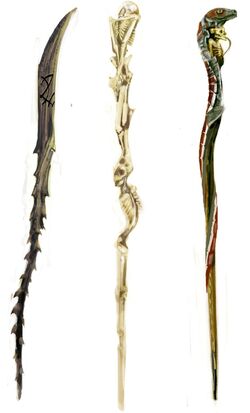
Three Death Eaters wands of different magical properties
Many wandmakers simply matched the wand length to the size of the witch or wizard who would use it, but this was a crude measure, and failed to take into account many other, important considerations. Longer wands might suit taller wizards, but they tended to be drawn to bigger personalities, and those of a more spacious and dramatic style of magic. Neater wands favoured more elegant and refined spell-casting. However, no single aspect of wand composition should be considered in isolation of all the others, and the type of wood, the core and the flexibility might either counterbalance or enhance the attributes of the wand’s length.[24]
Most wands would be in the range of between nine and fourteen inches. While extremely short wands (eight inches and under) and very long wands (over fifteen inches) existed, these were exceptionally rare. In the latter case, a physical peculiarity demanded the excessive wand length. However, abnormally short wands usually selected those in whose character something was lacking, rather than because they were physically undersized (many small witches and wizards are chosen by longer wands).[24]
Wand flexibility or rigidity denoted the degree of adaptability and willingness to change possessed by the wand-and-owner pair — although, again, this factor ought not to be considered separately from the wand wood, core and length, nor of the owner’s life experience and style of magic, all of which would combine to make the wand in question unique.[24]
New masters
- "Harry looked down at the hawthorn wand that had once belonged to Draco Malfoy. He had been surprised, but pleased, to discover that it worked for him at least as well as Hermione's had done."
- — Harry Potter won the allegiance of Draco Malfoy's wand[src]
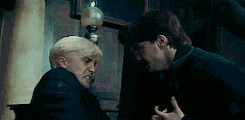
Harry Potter disarms Draco Malfoy and wins his wand
Wands could take new masters. When a wand's master was disarmed, stunned, or killed, the wand might accept the old master's attacker as its new master. It swayed its allegiance over to the wizard who had won it from its preceding owner. Wands with dragon heartstring cores were said to be more likely to change their alliegence, though they would bond most strongly with their original owners.[25]
Most wands were attached to their masters and would not easily discontinue their allegiance with the previous master, if at all. Indeed the original bond seemed unlikely to be severed; if it had been, then a defeated witch or wizard would have been better served to acquire a new wand rather than continue using it because it would have no longer performed at its peak for them — yet they didn't. Furthermore, wands forcibly taken in circumstances of purely competitive or friendly nature or stolen without attacking the previous master would not change allegiance.[26]
A notable exception to this general rule was the Elder Wand, which, according to Albus Dumbledore, only respected power. The Elder Wand would transfer its allegiance even if its defeated master was not in possession of it at the time. No other wand was known to share this trait. The Elder Wand's alliegence could be won as simply as by forcibly taking it from its current master's hand, as Harry Potter did with Draco Malfoy, although it was more frequentely obtained by murder.[27]
Reverse Spell
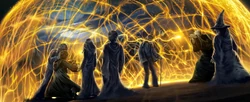
A famous instance of the Reverse Spell effect occurred during Harry Potter's and Lord Voldemort's duel in Little Hangleton
A record of all the spells a wand had used could be checked using the Reverse Spell. This was a prime reason why criminals who wished to act discreetly would not use their own wands to perform illegal spells, fearing this record would betray them; instead, they could borrow someone else's wand to act with impunity, letting the other owner take the fall.[28][4] The record seemed to be rather intricate, as Peter Pettigrew took Voldemort's wand in fear it might reveal his treason, suggesting the wand had such records (such as branding the Dark Mark onto Pettigrew himself).[29]
Damage and underwater use

Lockhart using a broken wand to cast a Memory Charm, which backfired onto himself
Spells and physical damage could irreparably damage wands, destroying or greatly diminishing their magical abilities. Attempts to repair the wand would not be effective, and the wand might break again while performing magic, or even backfire, as was the case with Spellotaped wands.[30]
The only known way to fully repair a broken wand was through mastery of the Elder Wand, although this ability might be lost if the current master died undefeated because most of the wand's power would disappear with them.[27]
In addition, wands seemed to possess the capability to function underwater, although the appearance of spells might change, as was demonstrated when Harry Potter attempted to use a Revulsion Jinx to free himself from the grip of several Grindylows. Harry noted that instead of "sending sparks at the Grindylows", it "pelted them with what seemed to be a jet of boiling water".[28]
Acquiring a wand

Harry Potter acquiring his wand at Ollivanders
Most witches and wizards bought their first wand when they were eleven — just before starting their magical education. Most English wizards and witches bought their wands at Ollivanders in Diagon Alley, where they would try out multiple wands until they found the one that suited them, or rather, the wand found the wizard that suited it. Some witches and wizards, especially those from poorer backgrounds, were left to use wands that had not chosen them but chosen a member of their family: Ron Weasley, for example, used his brother Charlie's old wand when he began his first year at Hogwarts.
In the United States of America, upon purchasing a wand, the buyer was given a Wand Registration Number, which was required for applications for wand permits. MACUSA had a Central Wand Archive.[31]
Rights of usage
- "The right to carry a wand has long been contested between wizards and goblins."
- — Griphook a goblin over the right to carry a wand[src]
The right to carry a wand at all times was established by the International Confederation of Wizards in 1692, when Muggle persecution was at its height and the wizards were planning their retreat into hiding.[32]
Non-human beings as goblins and house-elves were prohibited from owning or using wands. For goblins in particular, this prohibition had been a point of contention with the wizarding community and caused some outbreaks of violence. No known formal prohibition existed against Muggles possessing a wand; they would be unable to use them anyway since Muggles didn't possess magic, but a Muggle's possession of a wand could be considered a breach of the International Statute of Wizarding Secrecy.
Any underage wizards or witches who were expelled from school were forbidden from practising magic any further, and their wands had been confiscated and destroyed. Rubeus Hagrid's wand suffered such a fate, though it was somewhat repaired and kept inside his umbrella, and he was allowed to use that much. However, if the student in question was expelled after taking the Ordinary Wizarding Level, they were deemed to be full-fledged wizards and might retain their wands, as Newton Scamander did when he was expelled. Gellert Grindelwald was expelled from Durmstrang, but he managed to maintain his wand (or procure another one), suggesting the wand confiscation may have only applied to Hogwarts students. Of course, any criminals arrested and imprisoned lost their wands as well: Barty Crouch Jnr claimed that he was not allowed a wand since Azkaban; though their wands seemed not destroyed but simply stored away because Bellatrix Lestrange managed to retrieve her old wand after escaping prison.
Years ago, due to Rappaport's Law, no underaged North American witch or wizard was allowed a wand until they arrived at Ilvermorny School of Witchcraft and Wizardry. Moreover, wands had to be left at Ilvermorny during vacations and only upon attaining seventeen years of age was the witch or wizard legally allowed to carry a wand outside school. However, this law had since been repealed (in 1965).
During the last year of the Second Wizarding War, the British Ministry of Magic was overthrown by the Death Eaters, and new laws were put into effect. Muggle-born witches and wizards were regarded as having "stolen" their magic from "real" witches and wizards, and their wands (which were also considered stolen) were confiscated. Those who were not imprisoned were usually left destitute.
Makers
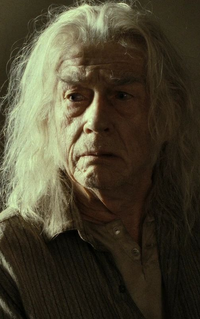

The wand was originally a European invention, and although many makers of wands existed, Ollivander was the best known and most experienced in Britain. The wandmaking establishment had been making wands since 382 BC and was in Diagon Alley, London. Mr Ollivander went missing in the summer of 1996[4] until discovered by Harry, Ron and Hermione and rescued by the house-elf Dobby in 1998; he had been kidnapped by Death Eaters on Voldemort's orders. Ollivander thereafter told Harry about the Elder Wand and how a wand passed ownership.[5]
More British wandmakers existed, for example, Jimmy Kiddell, but their wands were stated to be not as good as Ollivander's.
Another notable wand maker was Mykew Gregorovitch, who had once obtained and studied the Elder Wand. Gregorovitch's reputation rivalled that of Ollivander's with some, like Viktor Krum, considering his wands the best in the world. Krum's statement also suggests this view was more common outside of Britain. By 1997 he had retired as a wand maker, with Krum purchasing one of his last wands. In 1997, Voldemort tracked him down, as part of his quest to find and obtain Elder Wand. However, by that time, the wand had long since it had left Gregorovitch's possession, having been stolen by a blond-haired young man that the wand maker had never identified. Once Voldemort finished questioning Gregorovitch, he murdered him as he was of no more use to the dark wizard.[27]
Historical wandmakers in North America included Isolt Sayre, Violetta Beauvais, Johannes Jonker, Thiago Quintana, and Shikoba Wolfe, each of whom specialised in a single type of wand core.
According to legend, Death created the Elder Wand, the most powerful wand in existence, from the branch of an elder tree. Albus Dumbledore, however, believed that Antioch Peverell was more the likely creator.[33]
Known wands
| Owner | Wood | Length | Core | Flexibility | Notes |
|---|---|---|---|---|---|
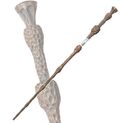 |
Elder | 15" | Thestral tail hair | Unknown | The Elder Wand, one of the Deathly Hallows. Also known as the Deathstick and the Wand of Destiny. |
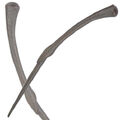 |
Walnut | 12¾" | Dragon heartstring | Unyielding | This wand is described as "unyielding;" passed into the possession of Hermione Granger after the Skirmish at Malfoy Manor in 1998. |
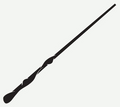 |
Blackthorn (according to legend) | 9" (according to legend) | Troll whisker (according to legend) | Combustible (according to legend) | This wand was broken during Sir Cadogan's encounter with the Wyvern of Wye. However, Cadogan still tried to combat the beast even with a broken wand, which led to his victory when the wand pierced the Wyvern's tongue and ignited its stomach fumes.[3] |
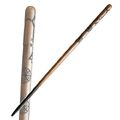 |
Ash[34] | 12¼"[34] | Unicorn hair[34] | Pleasantly springy | This wand was "pleasantly springy"; hair from particularly fine male unicorn (seventeen hands high), which nearly gored Mr Ollivander with its horn after he plucked its tail hair.[34] |
| Celestina Warbeck | Larch | 10½" | Phoenix feather | Flexible | Celestina Warbeck's wand is mentioned in the lyrics of the title track of her best-selling album, You Stole My Cauldron but You Can't Have my Heart.[35] |
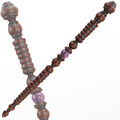 |
Birch | 8" | Dragon heartstring | Unknown | This wand is described as "unusually short;" broken by a centaur's hoof in June 1996 in the Forbidden Forest.[36] |
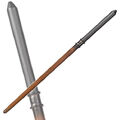 |
Hawthorn[5] | 10"[5] | Unicorn hair[5] | Reasonably springy[5] | This wand passed into the possession of Harry Potter after the Skirmish at Malfoy Manor in 1998 until Harry came into possession of the Elder Wand and mended his first wand.[5] |
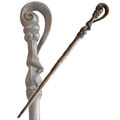 |
Rosewood[34] | 9½"[34] | Veela hair[34] | Inflexible[34] | In this wand the core is a hair from Fleur's grandmother, who was a Veela.[34] |
| Hornbeam | 12¾" | Dragon heartstring | Slightly bendy | ||
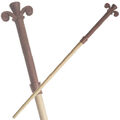 |
Cherry | 9" | The wand was described as expensive. | ||
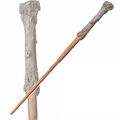 |
Holly[22] | 11"[22] | Phoenix feather[22] | Nice and supple[22] |
"Brother" to Voldemort's wand — the core tail feathers are both from Fawkes; broken in December 1997 while fleeing from Godric's Hollow;[22] repaired with the Elder Wand in May 1998.[27] |
|
Harry Potter (wand #2) 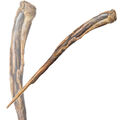 |
Blackthorn | 10" | Unknown | Unknown | This wand was taken from a Snatcher by Ron Weasley in 1997, and used by Harry until 1998, when he took Draco Malfoy's wand. |
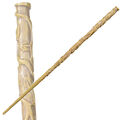 |
Vine | 10¾" | Dragon heartstring | This wand was confiscated when the trio was captured by Snatchers in 1998. | |
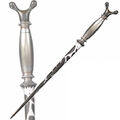 |
Cedar | 10¼" | Fairly flexible | ||
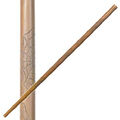 James Potter's wand |
Mahogany[22] | 11"[22] | Unknown | Pliable[22] | This wand was "excellent for transfiguration."[22] |
| Lily Evans | Willow[22] | 10¼"[22] | Swishy[22] | This wand was "nice for Charm work."[22] | |
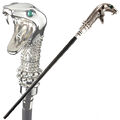 |
Elm | 18" | Dragon heartstring | Unknown | This wand was kept in a snake-headed walking stick that Lucius carried; "borrowed" by Lord Voldemort and destroyed by Harry Potter's wand during the Battle of the Seven Potters in 1997.[27] |
| Mary Cattermole | Cherry | 8¾" | Unicorn hair | Unknown | This wand was confiscated by the Muggle-Born Registration Commission in 1997.[27] |
| Merlin | Believed to have been English oak.[3] | Unknown | |||
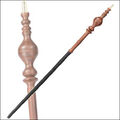 |
Fir | 9½" | Dragon heartstring | Stiff | This wand was most likely purchased from Ollivanders in 1947 when she was eleven almost twelve. |
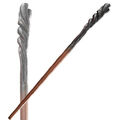 |
Cherry | Unknown | Unicorn hair | Unknown | This wand may have been one of the last wands Mr Ollivander sold before he disappeared in 1996. |
|
|
Chestnut | 9¼" | Dragon heartstring | Brittle | This wand was owned by Pettigrew only since Ollivander had been kidnapped of 1996; passed into the possession of Ron Weasley after the Skirmish at Malfoy Manor in 1998. |
| Quirinus Quirrell | Alder | 9" | Bendy | ||
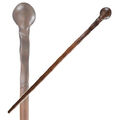 |
Cypress | 10¼" | Pliable | Cypress wands are said to be well-matched to wizards who are self-sacrificing and willing to die a heroic death. Lupin spent the majority of his life alone to save others from having to deal with the consequences of his affliction, and died defending Hogwarts castle in the Battle of Hogwarts. | |
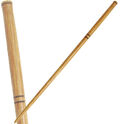 |
Ash | 12" | Unknown | Ron's brother Charlie's old wand; severely damaged in September 1992 after a run-in with the Whomping Willow. | |
|
Ron Weasley (wand #2) 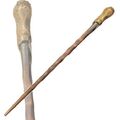 |
Willow | 14" | Purchased with his father's winnings from a Daily Prophet draw. Taken from him by Snatchers and replaced with Peter Pettigrew's wand. | ||
|
Ron Weasley (wand #3) |
Chestnut | 9¼" | Dragon heartstring | Brittle | This was Peter Pettigrew's wand. During the Skirmish at Malfoy Manor, Ron took this wand from Pettigrew and used from then on, as his own wand was taken by Snatchers. |
| Rubeus Hagrid | Oak | 16" | Unknown | Rather bendy | This wand was snapped in half when Hagrid was expelled from Hogwarts during his third year — the pieces are certainly hidden in Hagrid's pink umbrella. |
| Silvanus Kettleburn | Chestnut | 11½" | Phoenix feather | Whippy | |
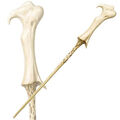 |
Yew | 13½" | Unknown | This wand is "brother" to Harry Potter's wand — the core tail feathers are both from Fawkes. | |
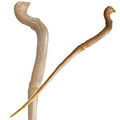 |
Hornbeam[34] | 10¼"[34] | Dragon heartstring[34] | Quite rigid[34] | This wand is thicker than usual, and made by Gregorovitch.[34] |
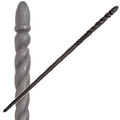 |
Yew | Unknown | A yew wand is suited for a person who is a fierce protector of others.[3] Protectiveness is an espect of Ginny's personality. She has frequently defended Harry Potter against others.[30][36][4] | ||
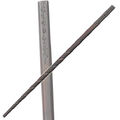 |
Hazel[3] | 9½"[3] | Unicorn hair[3] | Very flexible[3] | This wand bears a resemblance to Sirius Black's wand, though there are slight differences. They both have a square-like handle and have magical runes depicted on the wand, but Trelawney's wand has a darker colour and has a swirly shape from the handle to the tip. |
| Dylan Marwood | Applewood | Unknown | |||
| The Silver Spears | Aspen | The Silver Spears was a notorious and secretive duelling club in the 18th century that allegedly only allowed wizards and witches who possessed wands made from aspen wood to join.[3] | |||
| Eldritch Diggory | Poplar | Unknown | Fine | The existence of this wand and its owners was cited as evidence against a myth that poplar wands never chose politicians.[3] | |
| Evangeline Orpington | |||||
| Wands produced by Garrick Ollivander | Beechwood | 9" | Dragon heartstring | Nice and flexible | These wands were tried out by Harry Potter in 1991. |
| Maple | 7" | Phoenix feather | Quite whippy | ||
| Ebony | 8½" | Unicorn hair | Springy | ||
| Apple | 9" | Dragon heartstring | Rigid | A wand tried out by Jacob's younger sibling in 1984. | |
| Jacob | Maple | 10" | Dragon heartstring | Fine | Snapped in half when Jacob was expelled from Hogwarts. |
| Jacob's sibling (wand #1) | Maple | 14" | Unicorn hair | Reasonably springy | One of these four wands was bought by Jacob's younger sibling in 1984. |
| Acacia | 12" | Unicorn hair | Pliable | ||
| Hornbeam | 11" | Dragon heartstring | Inflexible | ||
| Blackthorn | 11¼" | Unicorn hair | Slightly springy and flexible | ||
| Jacob's sibling (wand #2) | Ebony | 11¼" | Dragon heartstring | One of these three wands was bought by Jacob's younger sibling in 1989 after their wand was destroyed by Patricia Rakepick. | |
| Redwood | 11" | Unicorn hair | |||
| Laurel | 12" | Phoenix feather | |||
| Chadwick Boot | Prickly Ash | Unknown | Horned Serpent Horn | Unknown | This wand was made by Isolt Sayre and James Steward; said to be "a wand of exceptional power." |
| Webster Boot | Unknown | Unknown | Horned Serpent Horn | Unknown | This wand was made by Isolt Sayre and James Steward. |
Behind the scenes
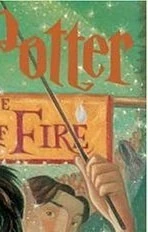
Wands drawn on the covers of the American version of the books by Mary GrandPré are shown as extremely long and thin
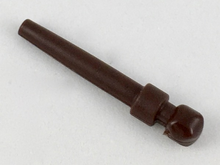
A LEGO wand
- In the films, the wands are shown a couple of inches longer than they are shown in the books. The films seem to include more gestures when using a wand, not just waving it and pointing it. The different styles were shown properly in the film version of the Battle of the Department of Mysteries. It may be explained that gestures and wand movements translate to incantations, even without words. This may allow one to speak the incantation without having to perform a specific gesture or wand movement.
- It is theorised that the wand's length is proportional to the wizard's height: the longer the wand, the taller the wizard, and the shorter the wand, the shorter the wizard. Although this pattern is generally supported (eg, Dolores Umbridge's short wand, Rubeus Hagrid's long wand) this may not always be the case. For example, Draco Malfoy, despite being tall, had a relatively short wand. However, J.K. Rowling stated that wands are generally shorter when witches or wizards are lacking in personality, rather than size.
- J. K. Rowling used a Celtic calendar to assign certain types of woods to Ron Weasley, Hermione Granger, and Harry Potter based on their birthdates.[37]
- Wands are Warwick Davis' favourite prop on the series.
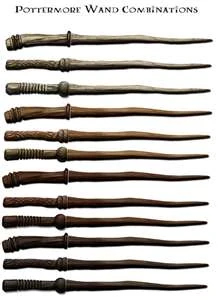
A variety of wands from Pottermore
- In the first and second films, wands look quite plain. The appearance of wands drastically change in the film adaptation of Harry Potter and the Prisoner of Azkaban, in which the wands are given distinctive shapes and carvings, reflecting the owner's personality.
- Devon Murray, who plays Seamus Finnigan in the Harry Potter films, has the record for breaking the most prop wands. He broke eighty of them.[38] Dan Radcliffe himself broke and damaged almost as many due to his habit of drumming with them.
- J.K. Rowling has said that Muggles cannot use a magic wand, yet residual power stored in a wand may discharge at odd moments, having potentially disastrous effects for a non-wizard.[39] One example of this happening was when, in 1790, Muggle Bartholomew Barebone stole Dorcus Twelvetrees's wand and showed it to many reporters. The wand was said to have "a kick like a mule" when waved. Another example of such behaviour occurred when a Muggle by the name of James Stewart attempted to wave a wand, causing it to "rebel" and send him flying into a tree, knocking him out. This result was described as what "invariably happens when a No-Maj waves a wand".
- Although Harry's wand is known to be made of holly (an almost white wood), his prop wand is significantly darker, suggesting a different wood. However, other wands appear to be varnished or coloured, so this isn't necessarily a break in continuity. Wood is a matte material so most if not all wands in the films have some kind of colour treatment.
- Wands have been used a total of 763 times in the books, according toPottermore.[40]
- Jacob's sibling's wands are determined by the answer the player gives to the questions Ollivander poses to the character during their wand selection. During the game's beta release, a fourth response existed in the first year ("I wanted answers") that would give the Maple wand, but is no longer available to players. An error exists during the selection of the character's second wand where Ollivander will mention that the player received the Hornbeam wand as their first, regardless of their choice.[41][42][43]
- Cherry wood wands being sought after in Japan, and their masters receiving special prestige, is likely a reference to the symbolism put on cherry blossoms 桜 (sakura) and their great popularity in Japanese culture. Sakura are also the national flower of Japan
Appearances
- Harry Potter and the Philosopher's Stone (First appearance)
- Harry Potter and the Philosopher's Stone (film)
- Harry Potter and the Philosopher's Stone (video game)
- Harry Potter and the Chamber of Secrets
- Harry Potter and the Chamber of Secrets (film)
- Harry Potter and the Chamber of Secrets (video game)
- Harry Potter and the Prisoner of Azkaban
- Harry Potter and the Prisoner of Azkaban (film)
- Harry Potter and the Prisoner of Azkaban (video game)
- Harry Potter and the Goblet of Fire
- Harry Potter and the Goblet of Fire (film)
- Harry Potter and the Goblet of Fire (video game)
- Harry Potter and the Order of the Phoenix
- Harry Potter and the Order of the Phoenix (film)
- Harry Potter and the Order of the Phoenix (video game)
- Harry Potter and the Half-Blood Prince
- Harry Potter and the Half-Blood Prince (film)
- Harry Potter and the Half-Blood Prince (video game)
- Harry Potter and the Deathly Hallows
- Harry Potter and the Deathly Hallows: Part 1
- Harry Potter and the Deathly Hallows: Part 1 (video game)
- Harry Potter and the Deathly Hallows: Part 2
- Harry Potter and the Deathly Hallows: Part 2 (video game)
- Harry Potter and the Cursed Child
- Harry Potter and the Cursed Child (play)
- Fantastic Beasts and Where to Find Them: The Original Screenplay
- Fantastic Beasts and Where to Find Them (film)
- Fantastic Beasts: The Crimes of Grindelwald - The Original Screenplay
- Fantastic Beasts: The Crimes of Grindelwald
- Fantastic Beasts: The Secrets of Dumbledore
- The Tales of Beedle the Bard
- Quidditch Through the Ages
- Pottermore
- Wizarding World
- Harry Potter: A Pop-Up Book
- LEGO Harry Potter
- LEGO Harry Potter: Building the Magical World
- LEGO Harry Potter
- LEGO Harry Potter: Years 1-4
- LEGO Harry Potter: Years 5-7
- LEGO Dimensions
- LEGO Creator: Harry Potter
- Creator: Harry Potter and the Chamber of Secrets
- Harry Potter for Kinect
- Harry Potter: Spells
- The Making of Harry Potter
- The Wizarding World of Harry Potter
- Harry Potter and the Deathly Hallows: Motorbike Escape
- Harry Potter Trading Card Game
- Fantastic Beasts: Cases from the Wizarding World
- Wonderbook: Book of Spells (Also simulates use of wand via PlayStation Move controller)
- Wonderbook: Book of Potions
- Harry Potter: The Character Vault
- Harry Potter: The Creature Vault (Mentioned only)
- Harry Potter Official Site
- Harry Potter: The Wand Collection
- Harry Potter: Hogwarts Mystery
- Harry Potter: Wizards Unite
- Harry Potter: Magic Awakened
- Harry Potter: Puzzles & Spells
- Hogwarts Legacy
Notes and references
- ↑ Harry Potter and the Deathly Hallows, Chapter 21 (The Tale of the Three Brothers)
- ↑ The Tales of Beedle the Bard
- ↑ 3.00 3.01 3.02 3.03 3.04 3.05 3.06 3.07 3.08 3.09 3.10 3.11 3.12 Pottermore
- ↑ 4.0 4.1 4.2 4.3 Harry Potter and the Half-Blood Prince
- ↑ 5.0 5.1 5.2 5.3 5.4 5.5 5.6 5.7 5.8 Harry Potter and the Deathly Hallows, Chapter 24 (The Wandmaker)
- ↑ The Tales of Beedle the Bard, pg 104
- ↑ 7.0 7.1 Writing by J. K. Rowling: "Uagadou" at Wizarding World
- ↑ 8.0 8.1 Writing by J. K. Rowling: "1920s Wizarding America" at Wizarding World
- ↑ Harry Potter and the Philosopher's Stone, Chapter 5 (Diagon Alley) - "The last shop was narrow and shabby. Peeling gold letters over the door read Ollivanders: Makers of Fine Wands since 382 B.C.
- ↑ Writing by J. K. Rowling: "Mr Ollivander" at Wizarding World
- ↑ Fantastic Beasts and Where to Find Them (2017 edition)
- ↑ 12.0 12.1 12.2 12.3 12.4 Writing by J. K. Rowling: "Ilvermorny School of Witchcraft and Wizardry" at Wizarding World
- ↑ Writing by J. K. Rowling: "Mahoutokoro" at Wizarding World
- ↑ 24 December 2007 PotterCast Interviews with J.K. Rowling
- ↑ Writing by J. K. Rowling: "Wand Woods" at Wizarding World
- ↑ https://shop.universalorlando.com/shop/harry-potter/collectibles/interactive-wands/interactive-ollivanders-alder-wand-1272546
- ↑ https://shop.universalorlando.com/shop/harry-potter/collectibles/interactive-wands/interactive-ollivanders-ash-wand-1272547
- ↑ https://shop.universalorlando.com/shop/harry-potter/collectibles/interactive-wands/interactive-ollivanders-holly-wand-1272552
- ↑ Wizarding World of Harry Potter - The Wand Chose ME! courtesy of YouTube (7:14)
- ↑ Writing by J. K. Rowling: "Wand Cores" at Wizarding World
- ↑ 21.0 21.1 21.2 21.3 21.4 21.5 21.6 21.7 Pottermore - History of America in North America
- ↑ 22.00 22.01 22.02 22.03 22.04 22.05 22.06 22.07 22.08 22.09 22.10 22.11 22.12 22.13 Harry Potter and the Philosopher's Stone, Chapter 5 (Diagon Alley)
- ↑ Harry Potter and the Deathly Hallows, Chapter 4 (The Seven Potters)
- ↑ 24.0 24.1 24.2 Writing by J. K. Rowling: "Wand Lengths and Flexibility" at Wizarding World
- ↑ Writing by J. K. Rowling: "Wand Cores" at Wizarding World
- ↑ Pottercast 131
- ↑ 27.0 27.1 27.2 27.3 27.4 27.5 Harry Potter and the Deathly Hallows
- ↑ 28.0 28.1 Harry Potter and the Goblet of Fire
- ↑ Rumours! section of J. K. Rowling's official site
- ↑ 30.0 30.1 Harry Potter and the Chamber of Secrets
- ↑ See this image
- ↑ Quidditch Through the Ages, pg 28
- ↑ The Tales of Beedle the Bard (real)
- ↑ 34.00 34.01 34.02 34.03 34.04 34.05 34.06 34.07 34.08 34.09 34.10 34.11 34.12 34.13 Harry Potter and the Goblet of Fire, Chapter 18 (The Weighing of the Wands)
- ↑ Inside the Magic: "Singing Sorceress: Celestina Warbeck and the Banshees in Diagon Alley at Universal Orlando" on Youtube
- ↑ 36.0 36.1 Harry Potter and the Order of the Phoenix
- ↑ Extra Stuff at J. K. Rowling's official site
- ↑ Harry Potter and the Deathly Hallows: Part 2 - Behind the Magic
- ↑ The Tales of Beedle the Bard, pg 83
- ↑ The Great Wand-o-Graphic from Pottermore
- ↑ Harry Potter: Hogwarts Mystery, Year 1, Chapter 1 (Your Journey Begins)
- ↑ Harry Potter: Hogwarts Mystery, Year 5, Chapter 17 (Broken Bonds)
- ↑ GameSkinny.com



